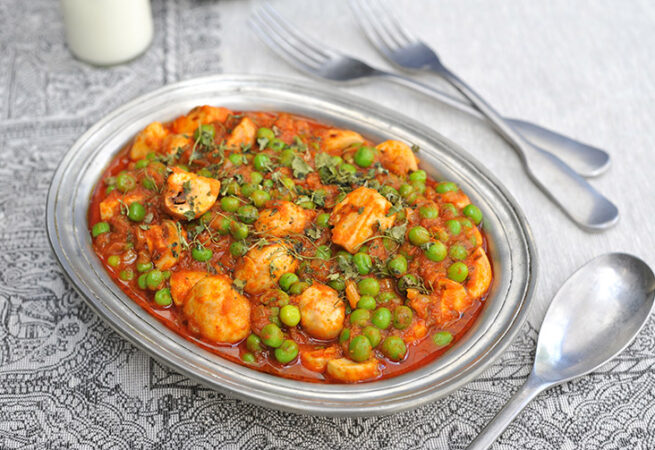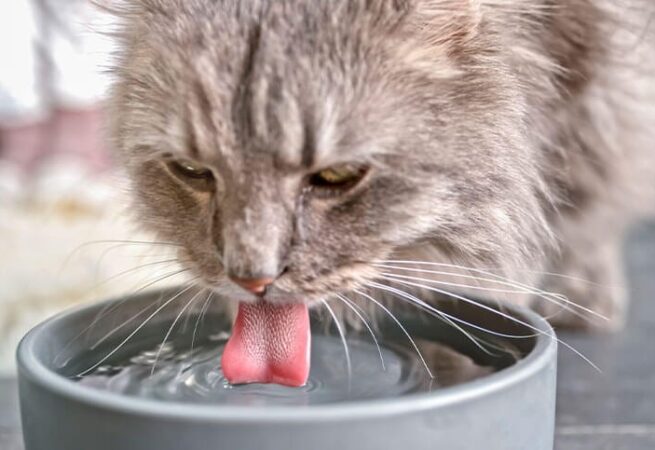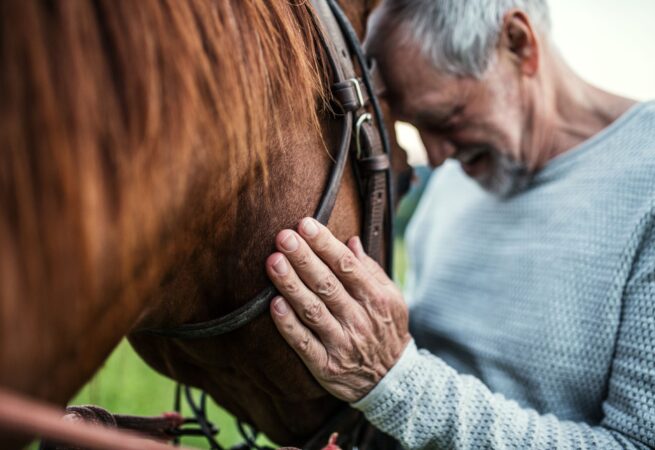

Do Cats Drink Water? Cat Hydration & Dehydration Prevention
Yes, they do. Although movies and other media often show cats drinking a bowl of milk, it’s not good for most felines.
Water, however, is as vital to a cat’s survival as it is to that of humans. 60-70% of their body weight is water. Despite being good for them, many cats don’t like drinking water, especially if it’s still or standing water. This dislike for water can lead to a dehydrated cat, so it’s important to monitor your cat’s water intake.

Why is Proper Hydration Important for Cats?
Hydration is the physiological state of balanced electrolytes, specific minerals and fluids within the body, and maintaining this balance is important. Water is vital because it affects everything from organ function and nutrient transportation to circulation and digestion.
It also helps decrease the likelihood of urinary stones and helps the kidneys flush out toxins.
All cats are different and have their own preferences, though. As a result, you may need to try a few different methods of providing water to find something your kitty likes.
What Causes Dehydration in Cats?
Cats can become dehydrated for a number of reasons. One of the primary reasons is it’s in their genes. Felines evolved from desert dwellers, and therefore have a low thirst drive and can survive on less water than their canine counterparts.
Cats have near-sightedness issues, so it may be hard for cats to visualize the edge of the water in a bowl. Additionally, when cats lap water from a bowl, they curve their tongue into a J-shape and bite off a column of water, which is incredibly inefficient. Cats only end up with 3/100 of a teaspoon per lap!*
Plus, cats are sensitive to the taste and presentation of water. Most cats instinctively gravitate toward fresh, moving water.
Conditions that make cats more prone to dehydration include chronic kidney disease and other conditions, such as diarrhea or diabetes.
Signs of Dehydration in Cats
If your cat neglects her water bowl, she may become dehydrated. Signs of a dehydrated cat include:
- Dry gums
- Lethargy or depression
- Loss of appetite
- Decrease in skin elasticity
- Elevated heart rate
You may have a dehydrated cat on your hands if you gently pinch the skin over her shoulders and the skin stays gathered when you release it. This is known as “skin tenting” and is a sign of dehydration.
If you notice any of the above signs, call your veterinarian. They can give your cat fluids, rule out any potential illnesses and offer guidance on preventing dehydration in the future.
How Much Water Should a Cat Drink?
Cats need varying amounts of water based on their weight and the type of food they eat (dry kibble or canned wet food).
It’s difficult for even the healthiest of cats to drink the right amount of water because of the unique shape of their tongues. A single lap of water only provides a cat with 3/100 of a teaspoon.*
Although many cats struggle to stay hydrated, some cats can drink too much water. If your cat drinks more water than usual, it may be a sign of feline hyperthyroidism or diabetes.
How to Get a Cat to Drink Water
Getting your cat to drink more water can be tricky. You may have to experiment until you find something she likes. Start with one or more of the following suggestions to see how your cat reacts.
Choose the Right Water Bowl: If your cat’s current water bowl is deep and narrow, it may touch her whiskers, which is uncomfortable. Try switching your cat’s water bowl to a wider, shallower dish with a smaller lip to see if she drinks more.
Place it in the Right Location: Although it’s tempting to stick your cat’s food and water bowls in an out-of-the-way area, cats don’t like being boxed into a corner. They prefer locations where they can see their surroundings with a quick glance and don’t have to worry about anyone sneaking up behind them. See if moving her water bowl to a new location helps.
Keep it Fresh: The longer water sits, the more particles it collects. Dust, dirt, hair and more can all collect in your cat’s water bowl, making her less inclined to drink from it. Put fresh water in her bowl one to two times a day.
Try a Cat Water Fountain: Cats love running water and there are many theories why. It may also appeal to more of their senses, as they can see it move, hear the sound it makes and even taste a difference. A cat water fountain can make drinking water more exciting and pleasurable for your kitty.
Add Wet Cat Food to Her Diet: Water isn’t the only way to keep your cat hydrated. If you’ve tried all the above and she’s still not drinking enough, try hydrating with wet cat food or broths. Although it can’t replace water altogether, supplementing with wet food can help increase her overall water intake to help prevent dehydration.
For some cats, even the fanciest water bowls and cat fountains and the most delicious wet foods aren’t enough. If your cat still isn’t drinking enough water, talk to your veterinarian. They may recommend a cat hydration supplement or give you more tips to help increase your cat’s water intake.
Not only do cats drink water, but it’s vital for their survival. Keeping your cat hydrated will help keep her happy and healthy. Explore all the wet cat food options we offer to help increase your cat’s total water consumption. Always check with your veterinarian before adding new food to your cat’s diet.
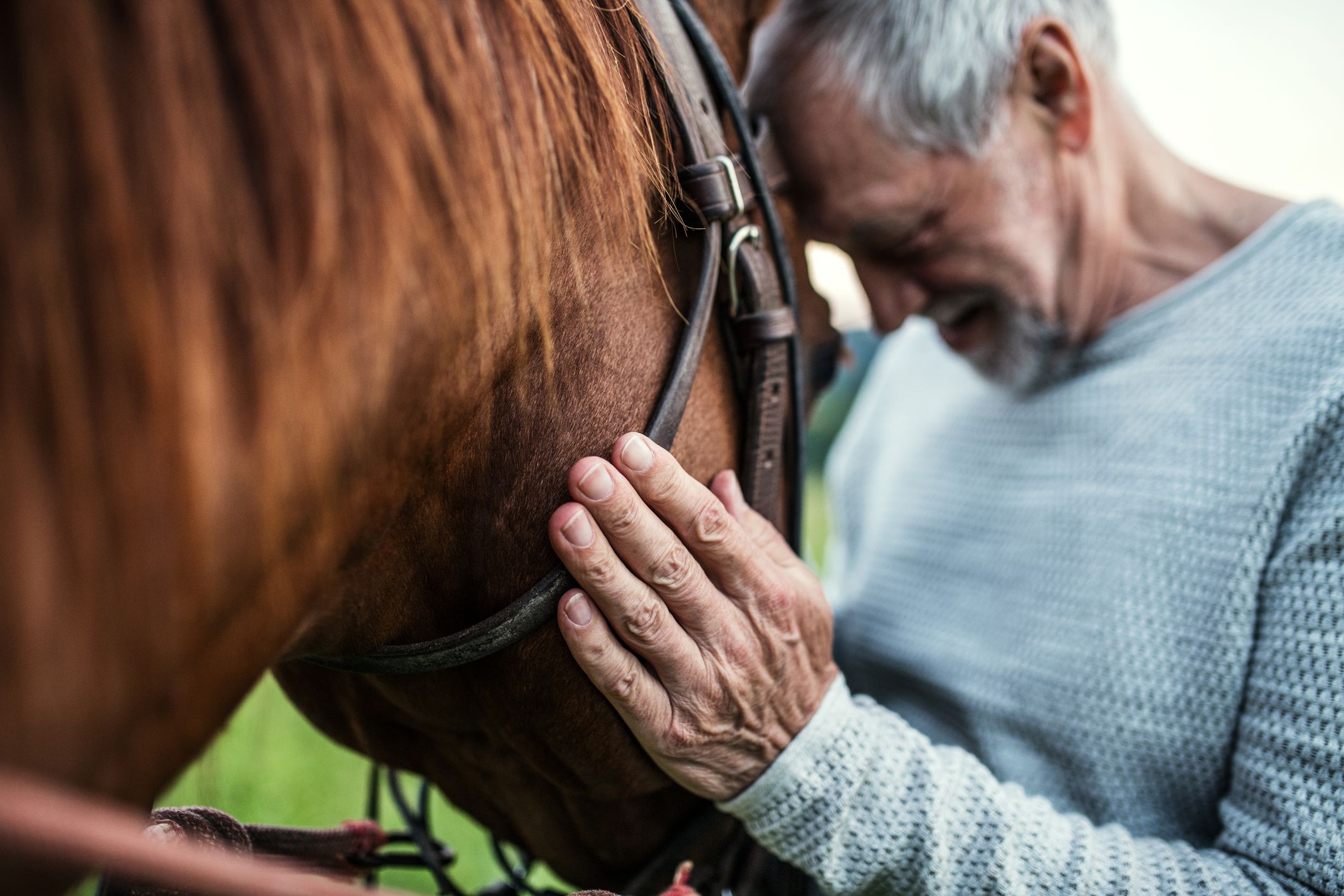
CONNECTING GOOD PEOPLE TO GOOD HORSES
Connecting Good People to Good Horses
Marketing is the process or technique of promoting, selling and distributing a product or service. Traditionally, marketing has not been the first priority for most adoption organizations. And rightfully so; the care of the horse is the first and most important focus. However, before a horse can be adopted into a loving home, the right person needs to be aware that the horse exists and is available for rehoming.
The Right Horse Initiative team attended an event last month where we had the opportunity to talk to an Arabian enthusiast who had been horse shopping for the past few months. She hadn’t found the right horse on the general market and was getting frustrated with her horse search. While she was interested in the concept, she expressed doubts that she could find the specific horse she desired through adoption. A passerby overheard this part of our conversation and interjected that she had previously felt the same way but had found a Halflinger mare at the first adoption organization she visited. Her testimony inspired other families at our booth to visit MyRightHorse.org and start their own quest to adopt.
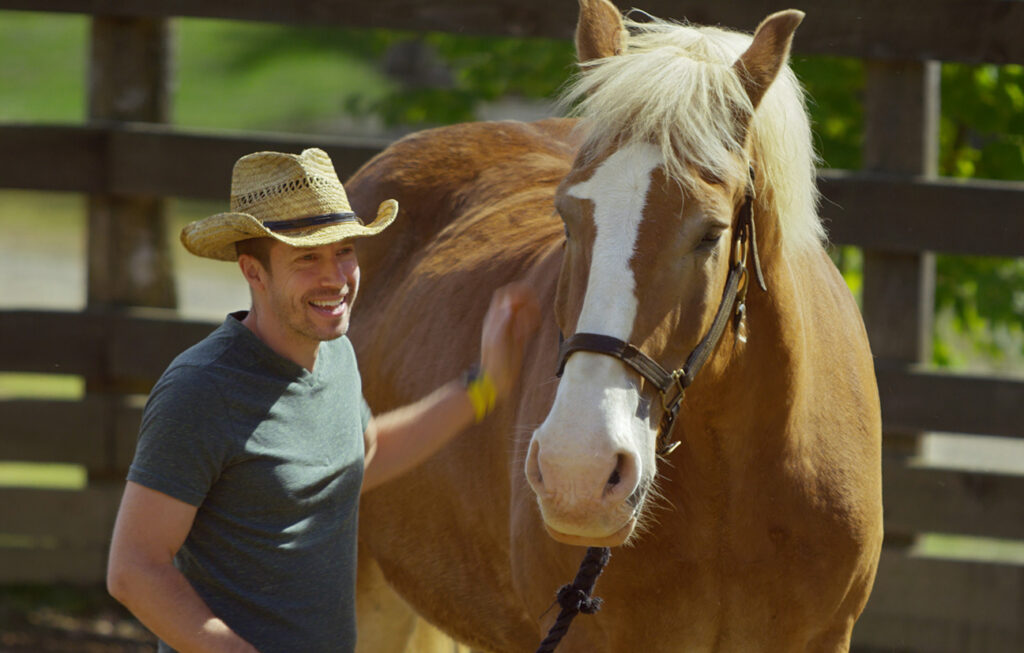
What if this type of conversation was the norm instead of the exception? The American Horse Council’s 2017 Economic Impact Study estimates that there are 7.1 million people in the United States owning or working with horses. What if we could make the 7.1 million horse people aware that adoption is another great option when looking to acquire a horse?
That is exactly what we are trying to do alongside our partners at The Right Horse Initiative. Our goal is to massively increase horse adoption; and a big piece of achieving that goal is increasing the demand for adoptable horses. Through innovative programming and a targeted effort to bring awareness into new communities, we can make a significant impact on horses in transition. We need to evaluate and elevate our existing marketing practices.
Our media partners, Horse Illustrated and Western Horseman, have been instrumental in getting the word out about adoption to new audiences. Horse Illustrated is currently running an adoption drive that has adoption-centric content on both their digital channels and print publications. Western Horseman has joined us in collecting Western All-Star Adoption Stories to promote successful adoptions of horses competing in the Western disciplines. Additionally, we are running an ad campaign in both magazines to promote adoption.
As we work to reach new segments of the horse industry and promote the general idea of adoption, more and more people are starting to become aware that adoption is a good option. Now that adoption is a concept on more people’s radar, the next step is connecting them to organizations in their area and make the adoption process engaging and accessible.
Searching for horses, whether via sale or adoption, has historically been a frustrating effort due to poorly created ads, lack of transparency and a multitude of other factors. To address the general inconsistencies we have seen in marketing horses, we have developed a new web app called My Right Horse. My Right Horse streamlines the search for adoptable horses by listing hundreds of adoptable horses in one place. Users can browse horses much like they would on any other horse sale site; by breed, age, discipline or location. The app takes a user-centric approach to make adoption an approachable, familiar and friendly option. In just the first few months since the initial launch, My Right Horse has proved that there are thousands of potential adopters curious about adoption with over 100,000 monthly page views. Now that we are gaining the public’s attention, we need to be ready with professionally presented horses and listings.
The manner in which we present an adoptable horse is an important piece of attracting the right adopter. Collectively, we need to highlight the skills and abilities of each adoptable horse and pair them with attractive, and high quality photos. Language should be positive and well edited. For example, consider the difference in these two sentences: “20-year-old gelding requires a companion-only home only due to a past injury” or “An older gentleman, Pepper has exceptional ground manners and has a lot to offer in a home where he could teach children and novices about how to handle horses.”. The second statement focuses on the horse’s abilities in a positive and engaging way.
As adoption gains more national attention and becomes a more common piece of the horse person’s vernacular and understanding, it will become even more important to represent adoptable horses in a professional manner. The demand and interest in adoptable horses is increasing and marketing is the key piece that connects the perfect home with the right horse.
Over the next few months we will be exploring different methods of marketing that have been successful in increasing quality horse adoptions. Marketing is the center point of creating change for horses in transition. It is the way we present our horses, our organizations and the way we engage potential adopters. Ultimately, marketing is the way we help horses in transition find their new loving homes.
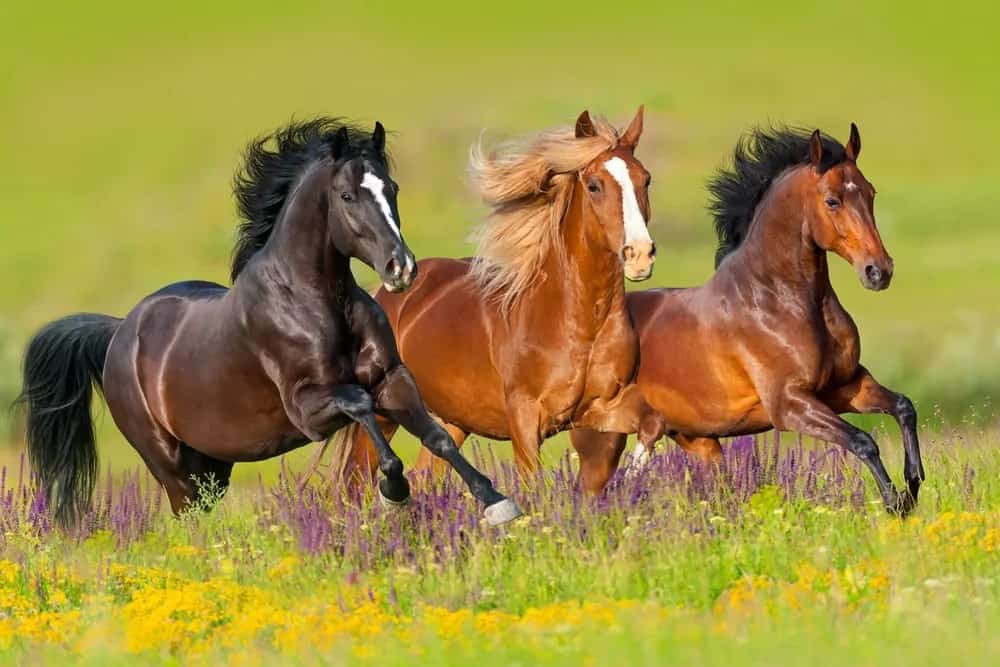
THE MYTH OF THE UNADOPTABLE HORSE
In today’s equine rescue world there seems to be a widely accepted belief that a large number of horses currently living in rescue groups or sanctuaries are unadoptable. Often these horses live the rest of their lives on the property and on the dime of the non-profit and their donor base. In theory this sounds like a lovely story, but is it really the most impactful way we can help at-risk horses? The extended length of stay of an “unadoptable” horse takes up a space that could have saved the lives of countless “adoptable” horses had they had a safe place to land. By adopting out a sanctuary horse, you are giving that particular horse the chance to be loved and cared for by a new owner while simultaneously opening the door to countless other horses needing help and care. So does it really make sense to support one at-risk horse for multiple years with the same donor dollars that could have placed dozens in new homes in that same time frame? Instead, why don’t we consider examining why these horses were labeled “unadoptable” in the first place?
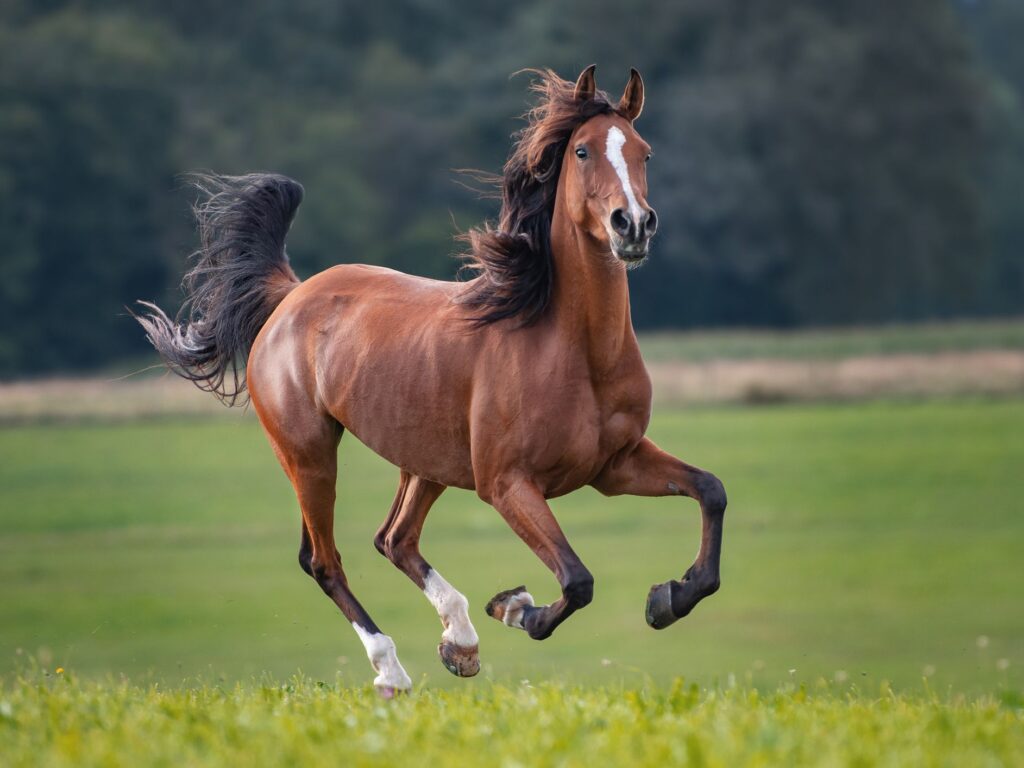
Common reasons for a horse being deemed unadoptable range from lameness issues, health problems, temperament problems or they are just plain old. Rescue groups/adoption agencies often give them the use of a paddock, lifelong healthcare and feed for as long as these horses will live. But, is it really necessary? If a horse is capable of living a quality life at a sanctuary, then why would it not be capable of doing the same in a private home? In fact, wouldn’t it be better for a horse with more advanced needs to be loved by a family in an adoptive home where it can receive individual attention?
First, let’s examine what an adoptable horse looks like. The definition of adoptable is a horse that is suitable or eligible for adoption. Generally, a horse is considered suitable for adoption if it has relatively safe ground manners (not dangerous to humans), and is healthy enough to live without suffering. These two factors are what delineates an adoptable horse vs. unadoptable. Is the horse likely to hurt someone on the ground and training efforts have failed to eliminate dangerous behavior? Is the horse going to suffer? The truth is, if either of these things are true about the horse, then the horse becomes a euthanasia candidate.
Veterinarians must always be involved in the euthanasia conversation. The American Association of Equine Practitioners has publicly posted widely accepted criteria for euthanasia to help guide equine veterinarians when making a euthanasia decision. The decision comes down to unmanageable pain and suffering. If a horse is so unhealthy that it is experiences ongoing suffering then it should not be in a sanctuary. Rather, the horse should be granted a humane ending. The decision whether and when to euthanize should always be made under the guidance of an equine veterinarian.
The good news is most sanctuaries in the United States are not filled with horses that are dangerous to people or live in a state of unmanageable suffering. In fact, most horses in organizations that are labeled unadoptable are simply old, not trained, have some manageable health issues or not able to be ridden.
Let’s go ahead and dispel some of the myths surrounding the mislabeled “unadoptable” horses. The untrained horses simply need some training to become adoption candidates. Old horses are not easy to adopt but they can be adopted, and therefore should be adoptable. What about the horses that have some health issues that make them ineligible for riding? Sometimes equine advocates can feel like an adopter couldn’t take care of a horse’s special needs. In fact, often these assumptions are wrong. There are adoption groups that have experienced great success placing special needs horses and companion horses. I’m not saying it is easy; but with creative marketing and a positive adoption philosophy it can definitely be done. There are adopters out there that are capable and willing to take on special needs horses. There are even some who enjoy providing extra care and feel fulfilled by providing a great home to a horse in need. Check out two ASPCA Pro webinars for great ideas and tips here and here.
In addition to benefiting individual horses, shifting to find homes for previously-deemed “unadoptable” horses opens up a whole new world for organizations. Let’s take a look at a rescue called Horses’ Haven. This fantastic adoption group in Howell, Michigan was established in 1995. This group truly identified itself as a sanctuary since inception. In 2015, they had approximately 70 horses in their care; 50 were considered sanctuary horses. They did under five adoptions a year and their 70-capacity barn was completely filled with “unadoptable” sanctuary horses. Then, something changed. They no longer wanted to say no to all the requests to help horses; but they were forced to say no as they had no space. In 2016, they decided to develop a strategy to move the sanctuary horses out of their rescue so they could begin to say yes again. Flash forward to one year later and they increased their adoptions to 36 horses! Each and every one of those horses adopted was originally considered unadoptable. How did they do it? They focused on training the horses and seeking out adopters that would tolerate some special needs. The board of directors no longer believed in the notion that sanctuary was the best place for the horses. They began to understand that if they placed these horses they could exponentially increase the number of horses they were able to help each year. The sanctuary became a legitimate and strong adoption program.
Another organization that is helping to dispel the myth of the unadoptable horse is the New Mexico Horse Rescue. In June of 2019, they placed a horse named Strawberry into a new home. What was special about Strawberry was she had been at their barn for eight years. She was a shy and introverted horse considered virtually unadoptable. However, with an increased effort by volunteers and staff to socialize and train her, suddenly her future was very bright. She even gained enough confidence to become a lesson horse in her adoptive home. Strawberry was not the only one. New Mexico Horse Rescue made a concerted effort to focus on their long timers and guess what…they placed many of them! It simply took their staff and volunteers deciding that these horses were valuable and adoptable.
Now what if half of the current sanctuaries in the U.S. did something similar in their programs? What if they decided to get creative, train the untrained, find the companion homes, change their own perspective? I’ll tell you what would happen; we would have the twice the capacity in this country to assist at-risk horses. We could help twice as many horses. In a world where adoption is one of the last considered options for acquiring a horse, don’t we need to be promoting the adoptability of ALL of our horses? If we ourselves are claiming that so many of our horse in care are unadoptable or sanctuary horses, aren’t we just re-affirming the public’s belief that we aren’t the place to go to get a horse? Instead, let’s take a long hard look at the horses in our care and really consider if they indeed are adoptable. Once we look at our own horses as adoptable, it is much easier to convince the public they should adopt them.

4 surprising activities to enjoy in Beau Vallon’s only beach-front hotel
Everyone who has visited the Seychelles even once knows the Beau Vallon beach on the north-western coast of Mahé. It’s a gorgeous ribbon of white soft sand set against a pretty floral backdrop. Plus it is famous for its superb diving opportunities.
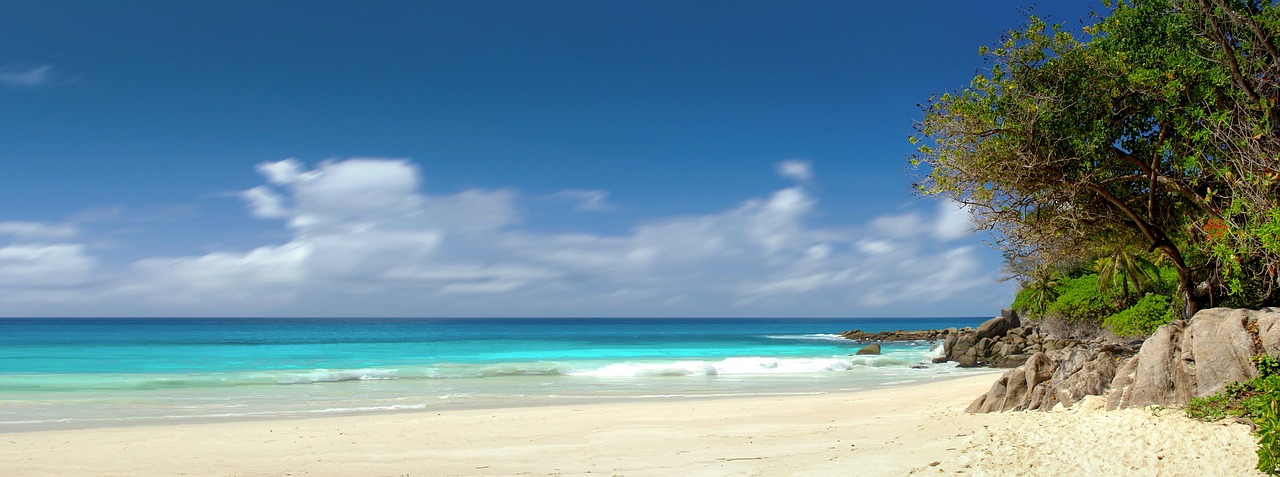
It’s a well protected area and government has banned building along the hemline, save for one solitary hotel that has been built directly on the beach: the Coral Strand Smart Choice Hotel. For beach lovers this is an idyllic venue and the only one that has easy access to diving, snorkelling and of course sunbathing.
With it’s amazing location staying here is a no-brainer. But be sure to enjoy these surprising activities:
Try a cooking masterclass
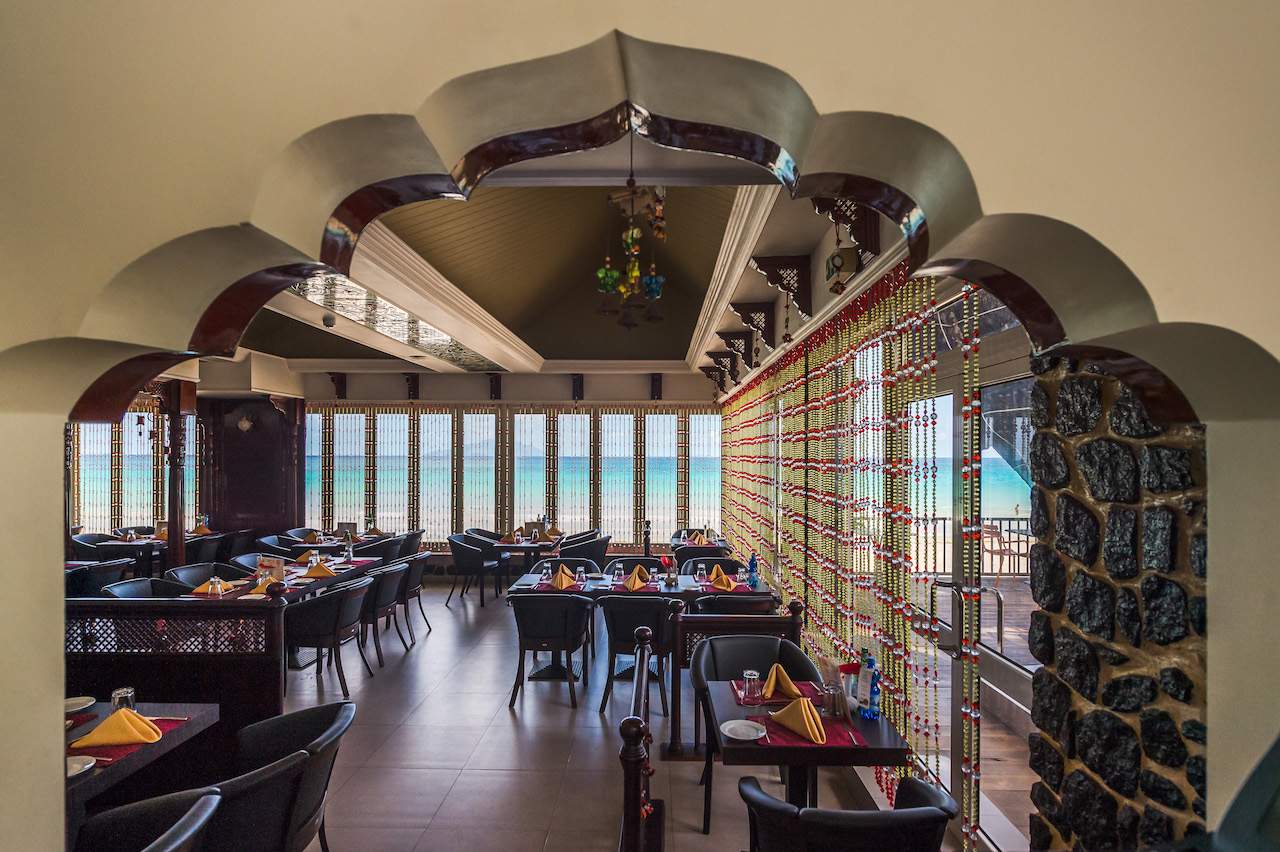
Restaurant “Mahek” at the Coral Strand
The Coral Strand has one of the best authentic Indian and oriental restaurants in the Seychelles called “Mahek”. You can watch as chefs from India and South-Eastern Asia create their dishes. Or join one of the cooking masterclasses held regularly at the hotel.
The “Coral Asia” restaurant is located on the upper terrace of the Coral Strand where you can dine to a backdrop of gorgeous ocean views that are particularly dramatic during sunset.
Experience the traditional “Moutya” dance at sunset

Get into the spirit and join a “Moutya”. This is the traditional dance of Seychellois that takes place on the beach.
It starts long before sunset by finding enough palm leaves for a bonfire. Once lit, dancers perform a local dance around it. When the fire is at its zenith the men begin to beat their drums increasing the rhythm and power while the women respond by singing and dancing around the fire. As the energy embraces the participants they are led into a trance-like state. It’s hard to resist joining in.
Spend an evening stargazing from the island’s only astronomical observatory

Experience the enthralling beauty of the Seychelles sky at night from the only astronomical observatory on the island. It is located on the roof top of the Coral Strand and you can gaze at the stars and appreciate how they twinkle so brightly thanks to the lack of pollution.
Take an invigorating hike on the island

Anse Major
Mahé has some wonderful hiking opportunities including a two-hour trail that begins not far from the Coral Strand. Follow the trail through dense tropical forest and open stone plateaus to the small and cosy Anse Major beach.
We recommend taking snorkelling gear as Anse Major is great place to enjoy the world under water. Fish swim close to the shore and so it’s ideal for young families to take the plunge.
The hotel can organise hiking trips to Anse Major and several other trails where you can experience the indigenous nature of the Seychelles.
Tip: Make sure you bring plenty of water, suncream and to wear appropriate shoes as some parts of the paths are steep and rocky.
More about Coral Strand Smart Choice Hotel
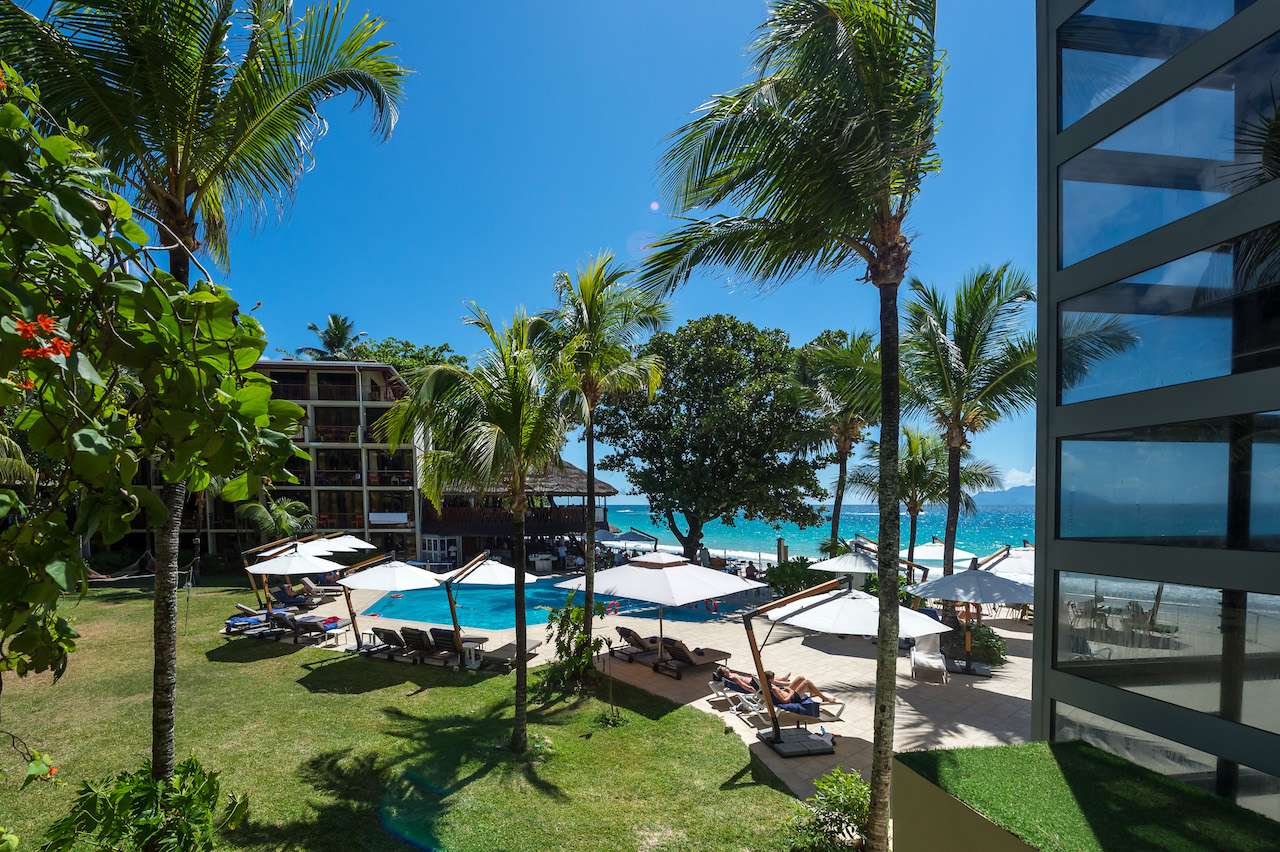
Coral Strand Smart Choice Hotel in Beau Vallon, Seychelles
Coral Strand is the only hotel in Seychelles located right on the beach. Just step out onto the Ocean Deck Bar, walk five metres and you are greeted by the calm waters of the Indian Ocean. The shutter windows of the Island Trader restaurant open directly onto the beach and sea which means you can take a dip while waiting for your order to arrive.
The Coral Strand can also organises classes that include basket weaving classes, making hats out of palm leaves, and how to break a coconut.
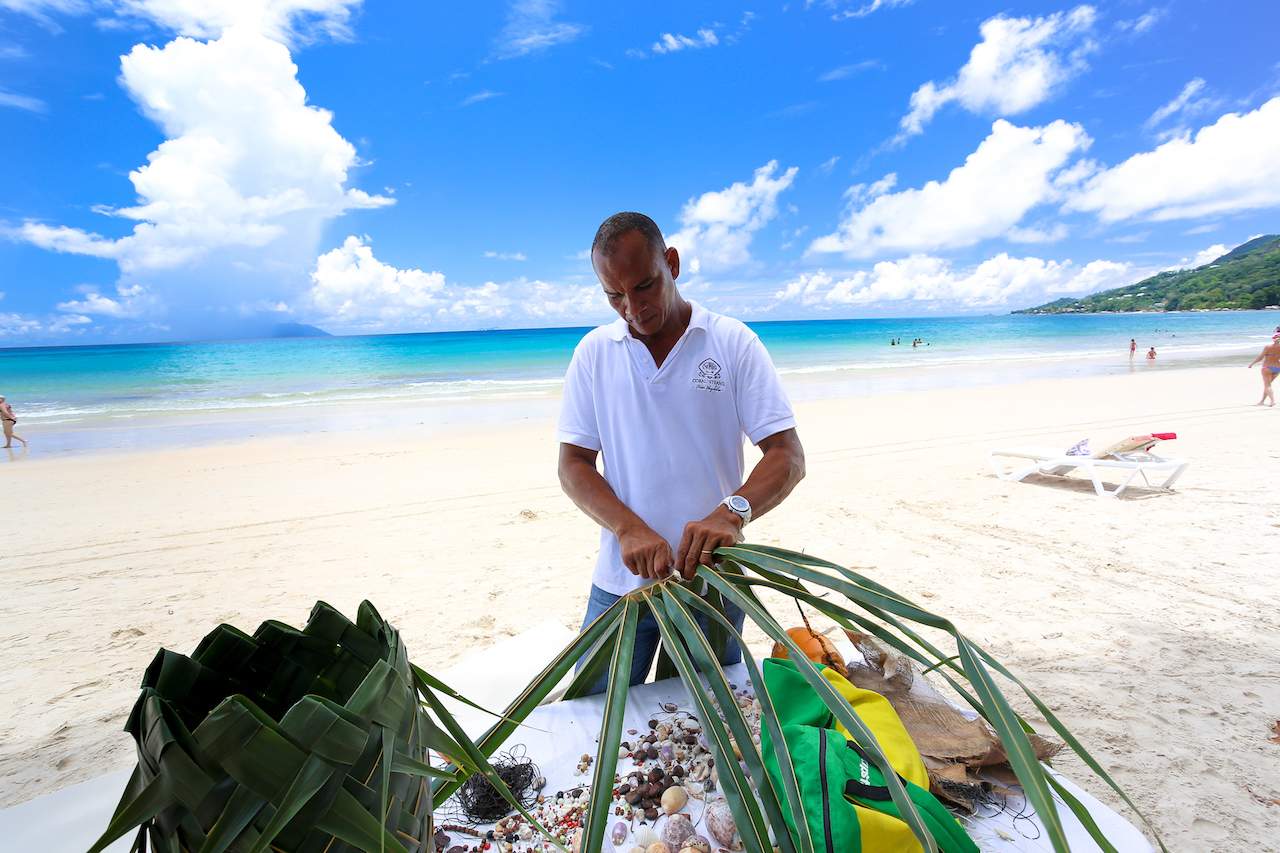

Deep South USA Music Triangle – Nashville, Tupelo and Memphis
A new direct flight linking London and Nashville is an opportunity to soak up the atmosphere of three music cities. Nashville is country music, Tupelo is the birthplace of Elvis and Memphis has soul.

You’ll need to hire a car, turn on the stereo and enjoy the drive. From Nashville, Tupelo is around four hours, then Memphis is another two hours.
If you’re feeling more adventurous then follow the Mississippi River south, exploring the land where the blues began.
Nashville, Tennessee
Music City USA is still the capital of country music and bars and honky-tonks line downtown Broadway. There’s good music in the clubs and at the famous Grand Ole Opry. Elvis appeared on stage here early in his career and made many of his famous recordings at RCA studios.
Ryman Auditorium
Celebrating its 125th anniversary in 2017, the Ryman Auditorium was originally a church and its seats are still as hard as any pews. It was the home of the Grand Ole Opry from 1925 until 1974 when it moved to a new venue on the outskirts of town. These days there are still concerts most nights and, in winter, the Opry moves back to its former home and broadcasts live.
The Station Inn
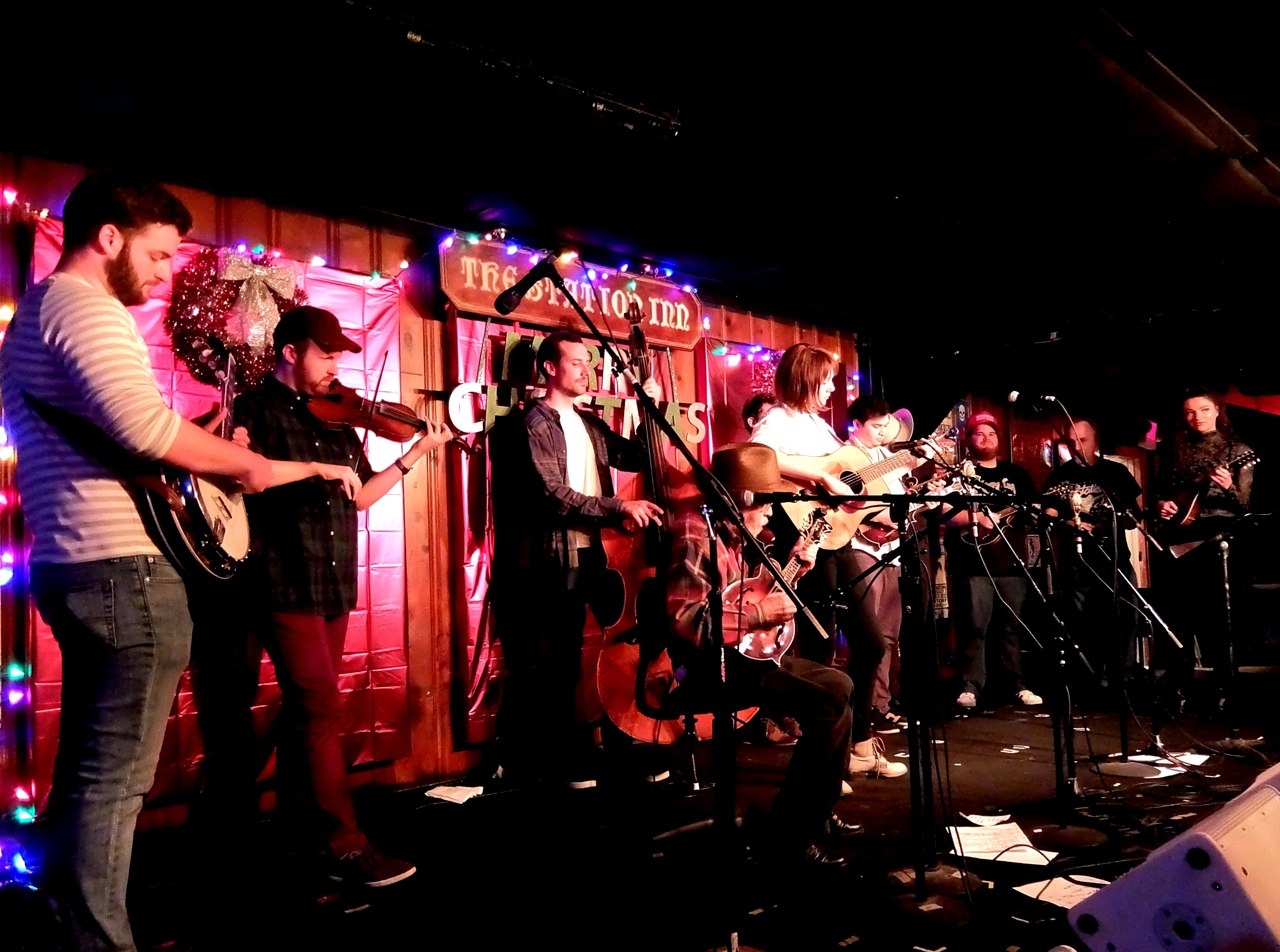
The Station Inn
For more than 40 years, The Station Inn has presented great bluegrass, roots and Americana music. It’s a small unassuming venue in the heart of Nashville, an area known as the Gulch. Many of the world’s most successful musicians have played at here, including Bill Monroe, Vince Gill, Alison Krauss and John Prine. What’s great is that it sells beer and pizza at pub prices and the admission prices are low.
Country Music Hall of Fame and Museum
Elvis, of course, is featured in the Country Music Hall of Fame and Museum and they’ve even got one of his gold plated Cadillacs. However he takes a back seat to this unrivalled collection of country music artefacts, recordings, photographs and videos, spreading over two floors. And it’s not all country – the most recent exhibition is dedicated to Bob Dylan, Johnny Cash and the Nashville Cats.
Studio B
After RCA bought his contract from Sun, Elvis started making money for the company and they built these studios in 1957, in part so he could record here. More than 35,000 songs were brought to life at Studio B, including over 260 Elvis recordings, 40 million selling singles, and more than 1,000 American hits – songs like Roy Orbison’s “Only the Lonely,” the Everly Brothers’ “Dream,” Dolly Parton’s “Jolene” and Elvis’s “Are You Lonesome Tonight?” A guided tour takes you round the studios, tells the story behind many of their greatest hits and you can even sit at the famous Elvis piano.
Tupelo, Mississippi
Elvis Aaron Presley was born in Tupelo, Mississippi, on January 8, 1935, to Vernon and Gladys Presley in a wooden two room shack, built by his father, grandfather and uncle. They moved out when he was only a few years old but, in 1957, he donated the proceeds of a concert to the city so they could create a park here.
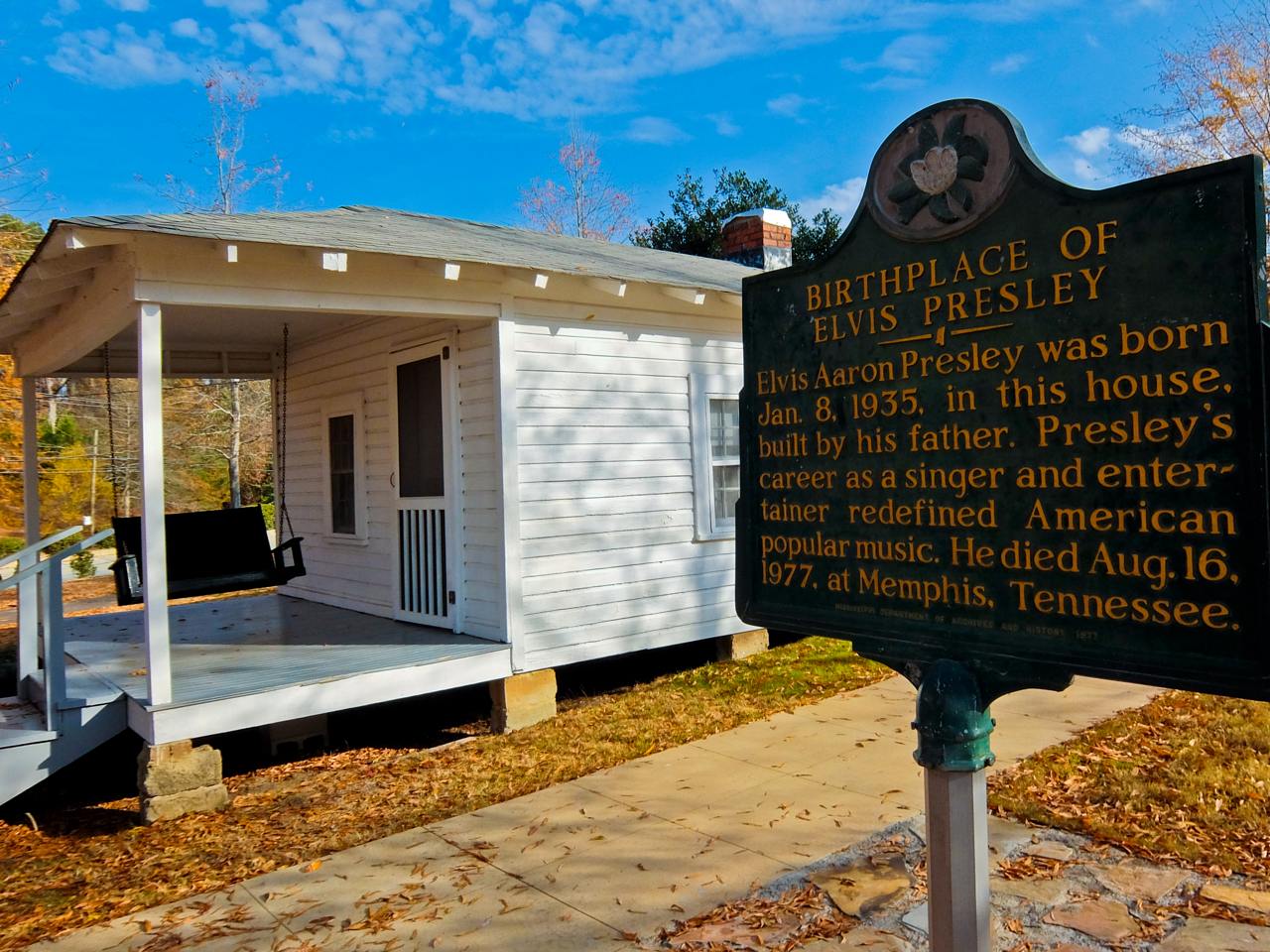
Elvis Birthplace
They purchased 15 acres, including the house and renamed the road around it Elvis Presley Drive. Of course the original furniture was long gone, but from 1971, the East Heights Garden Club made it their business to duplicate the house’s contents. You can now see how it might have been when the Presleys lived here in the thirties in the Elvis Presley Birthplace
Although the house now sits in green parkland, there used to be other houses nearby. In 2008, the Assembly of God Pentecostal wooden framed church was moved here from a block away. In this building, Elvis was first exposed to the rich Southern gospel that became a staple of his musical repertoire. Today, there are no live services, but instead a 15 minute multimedia recreation of a Pentecostal service from the 1940s.
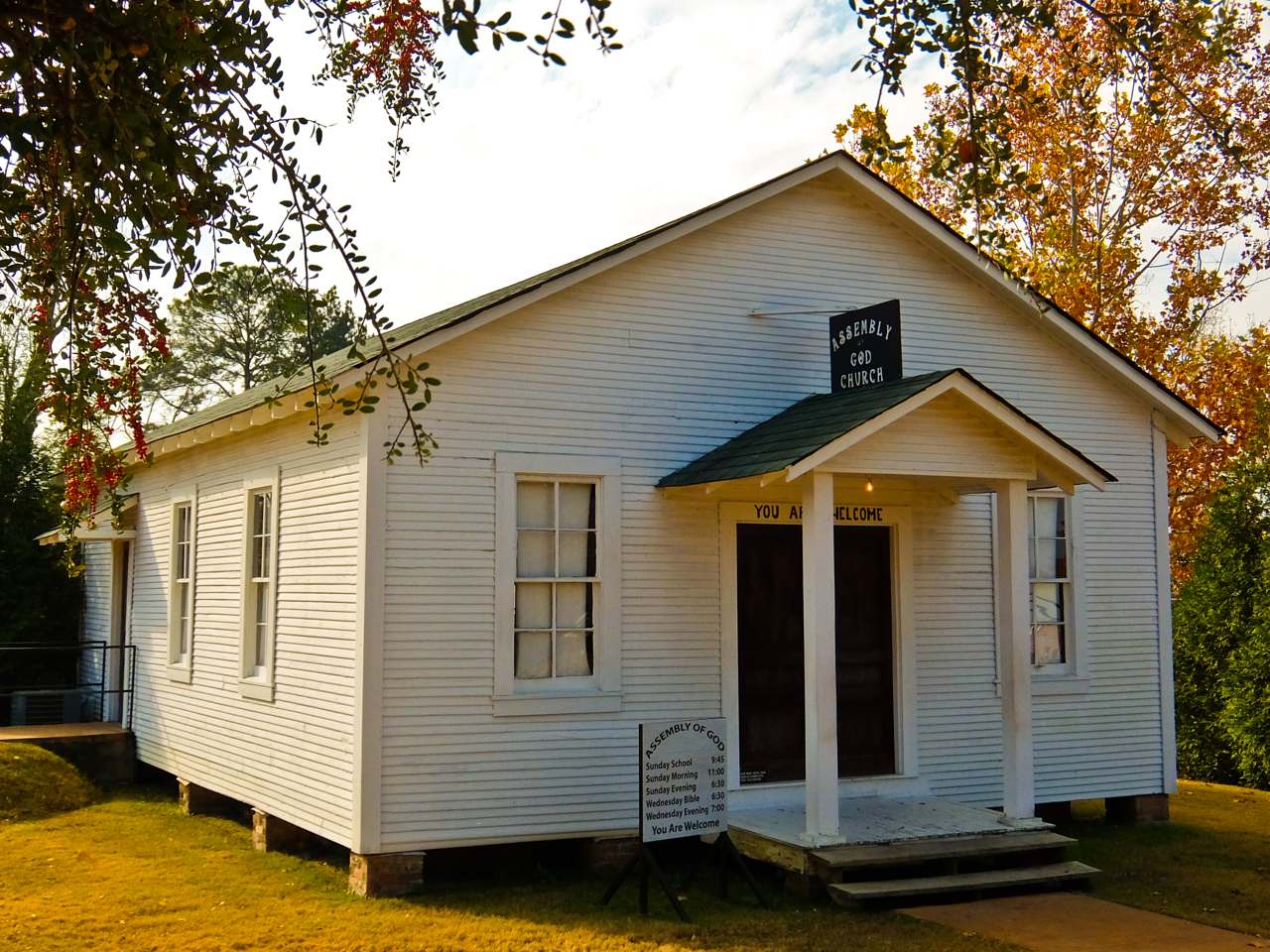
Elvis Church
There’s also a small museum displaying the collection of Janelle McComb, a Tupelo resident and friend of the Presley family. Highlights include examples of Elvis’s splendid dress sense – corduroy suits, an orange-striped parka, and fishnet and paisley shirts with puffed sleeves. A huge diorama shows the neighbourhood as it appeared during Elvis’s boyhood.
Memphis, Tennessee
After being the undisputed capitol of soul music, Memphis went into depression after the assignation of Martin Luther King Jr. at the Lorraine Motel here in 1968. These days it’s undergoing something of a revival, with funky clubs on Beale Street providing non-stop live music, and a new Stax museum and Academy. Even Graceland, Elvis’s home for most of his working life, is expanding.
Sun Studio

Sun Studio
Sam Philips founded this tiny studio in an unassuming brick building in 1950, little knowing it would become the birthplace of rock and roll. Elvis paid to record his first tracks here in 1953, but Sam Philips called him back in 1954. The result was his first hit “That’s Alright (Mama)”, and there were five more over the next fifteen months. You can almost feel the star magic as Jerry Lee Lewis, B.B. King, and many others recorded here. It’s still a functioning studio, although in use only at night, as hordes of fans pass through during the day.
Arcade Restaurant
A couple of miles away is the Arcade Restaurant, one of Elvis’ favourite haunts, and still growing strong. They’ve preserved his booth at the rear, where he would slip in unnoticed and sit with his back to the other diners. You can even order one of his favourites – a deep fried peanut butter and banana sandwich, although you might want to pass on the added bacon.
Graceland
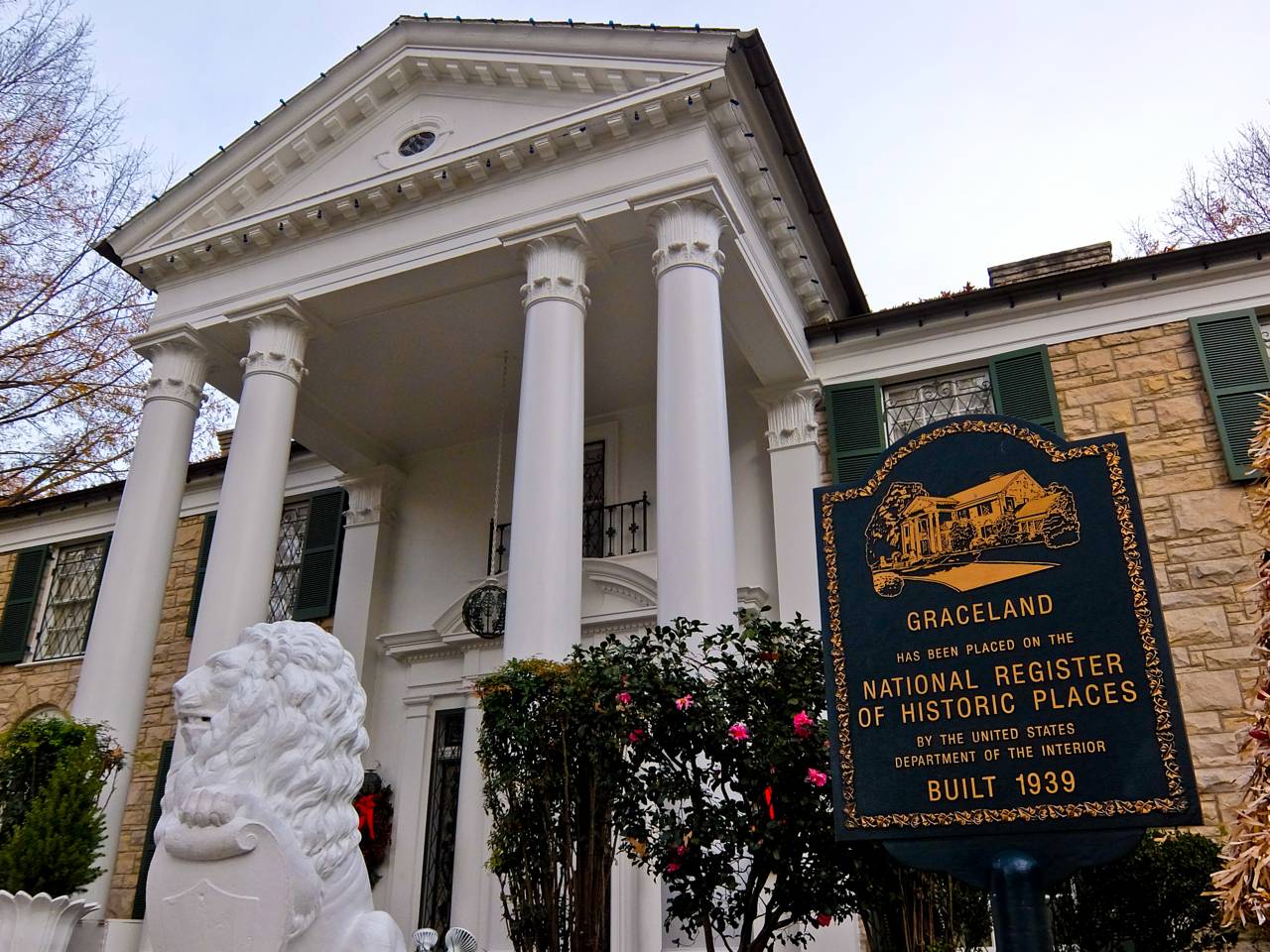
Graceland (c) Rupert Parker
Thirty minutes from downtown is Graceland, the house that Elvis bought in March 1957 and occupied until he died. It’s a surprisingly unassuming property and even the furnishings, bearing in mind the excruciating bad taste of 70’s, are not too ghastly. Of course it’s been kept exactly as he left it, and you can see his parent’s bedroom, the kitchen, jungle room and basement den, although upstairs is out of bounds. Apparently his daughter, Lisa Marie, still makes use of it during festive occasions. Elvis is buried next to his parents outside, at the foot of the swimming pool.
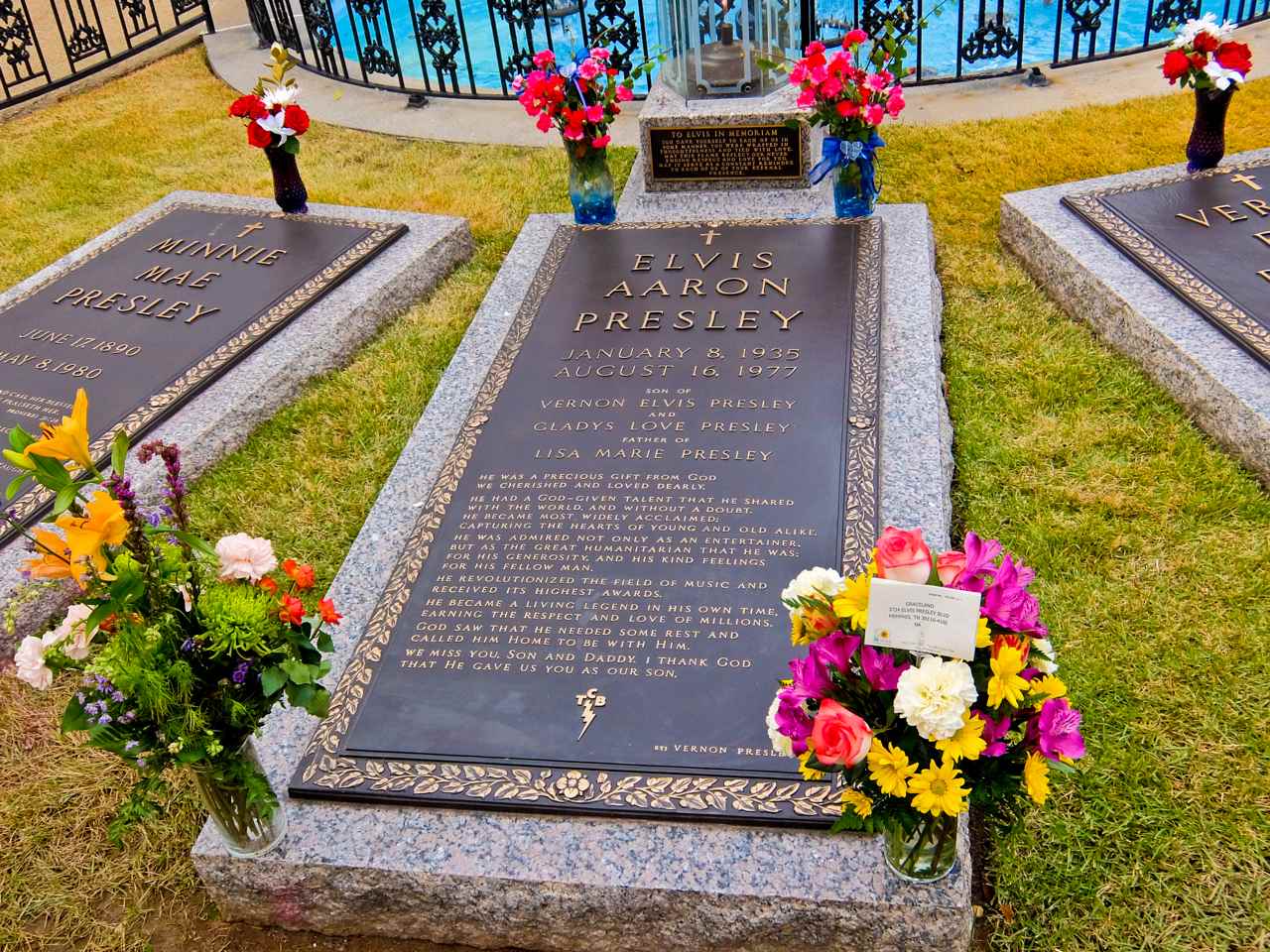
Elvis Grave
Recently the land on the other side of the road has been transformed into a sprawling entertainment, retail, dining and exhibition complex, now named Elvis Presley’s Memphis. The highlight is the museum celebrating his music, movie and concerts, with hundreds of artefacts including a collection of suspiciously small jumpsuits. In an adjacent building Presley Motors contains over 20 of his cars, including the iconic 1956 Pink Cadillac Eldorado, plus golf buggies, go carts and even a lawn mower. In a separate area sit two of his private jets and you can climb aboard the Convair 880, which has Lisa Marie’s name painted on the fuselage.
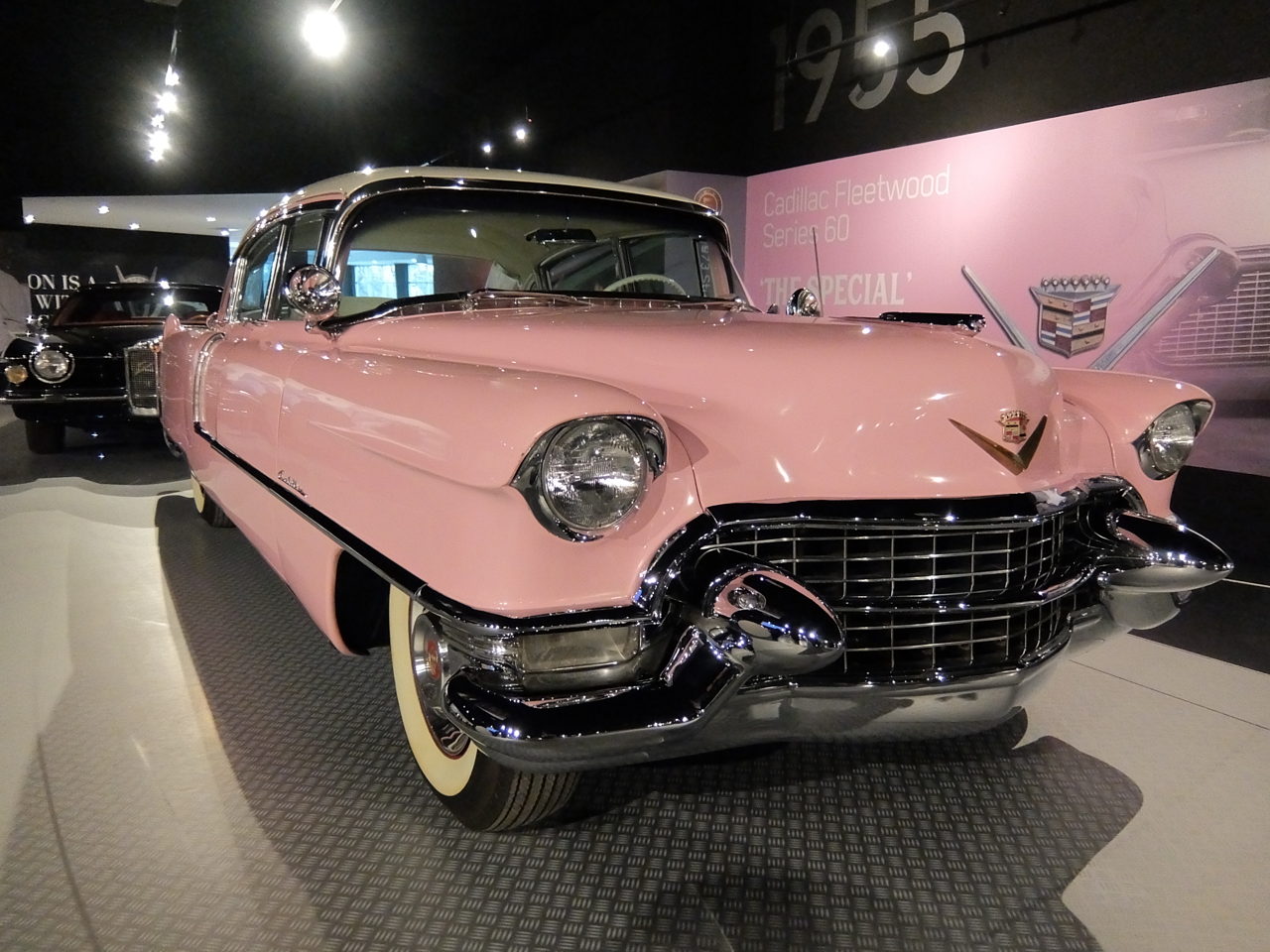
Elvis Pink Cadillac
Elvis loved home cooking so there are two themed restaurants named after his parents, Gladys and Vernon. Gladys’ Diner features classic American fare, including that famous Elvis sandwich and Vernon’s Smokehouse serves authentic Memphis BBQ, smoked in-house. Of course, if you’re after Elvis merchandise you’ll find the world’s largest collection on sale in the various gift shops.
Smithsonian’s Rock ‘n’ Soul Museum
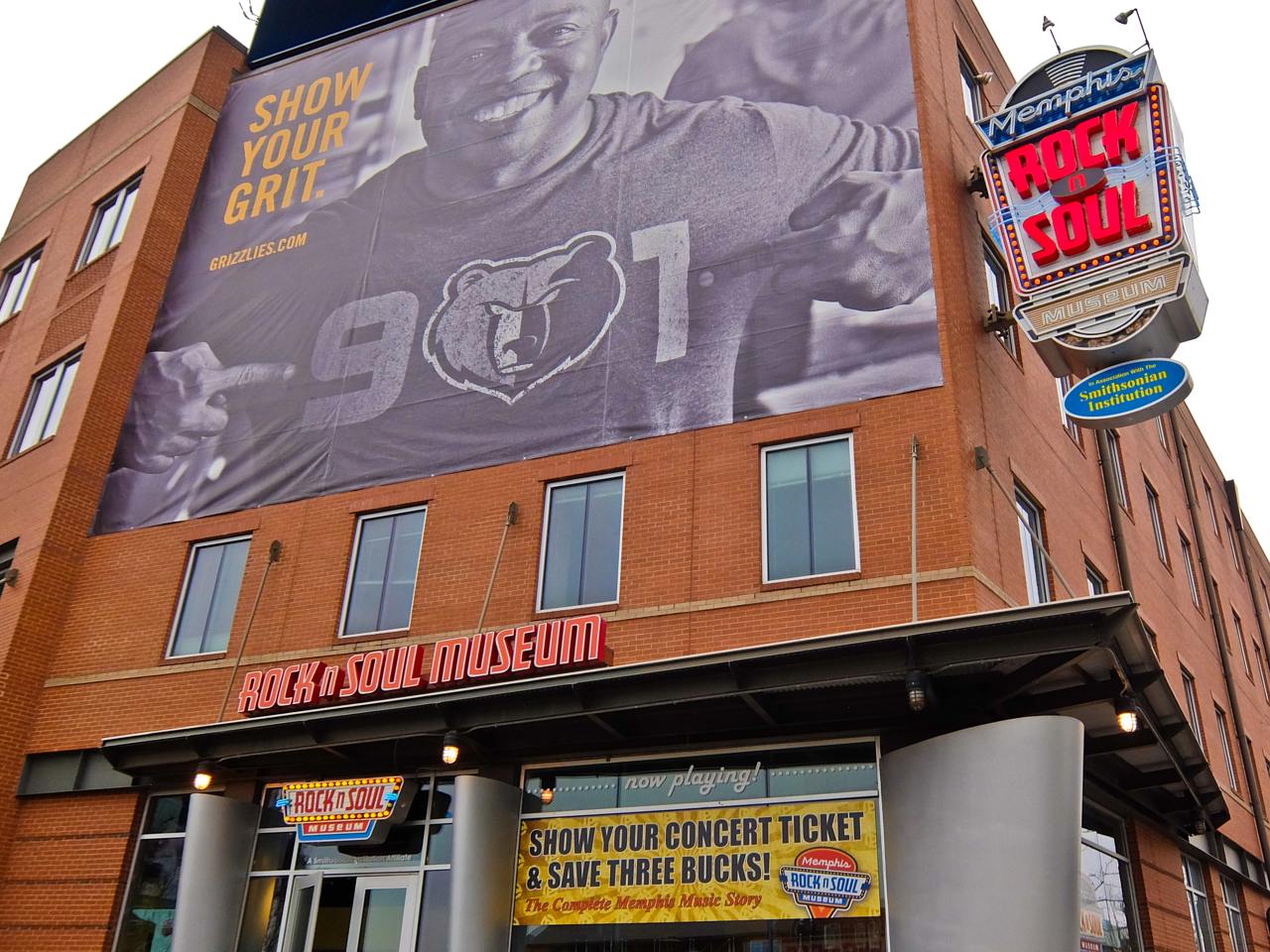
Rock and Soul Museum
Memphis, of course, isn’t just about Elvis and the Smithsonian’s Rock ‘n’ Soul Museum brings its impeccable eye to the story of the three important revolutions in music that happened here. It takes you from the birth of the blues in the ‘20s, rock and roll in the ‘50s and soul music in the ‘60s.
Stax Museum of American Soul Music

Stax Museum
In another part of town, Stax Studios has risen from the dead and is now the Stax Music Museum of American Soul Music. It includes a recreated studio plus artefacts from the time and a well laid out display telling the history. Next door there’s the Stax Music Academy which nurtures young black talent and stages occasion concerts.

Top 10 things to see and do in The Bahamas
The Islands Of The Bahamas with their famous pink sands and turquoise sea are home to 16 main islands and thousands of cays and islets which offer a wealth of diverse experiences. Here we pick out ten of the best:
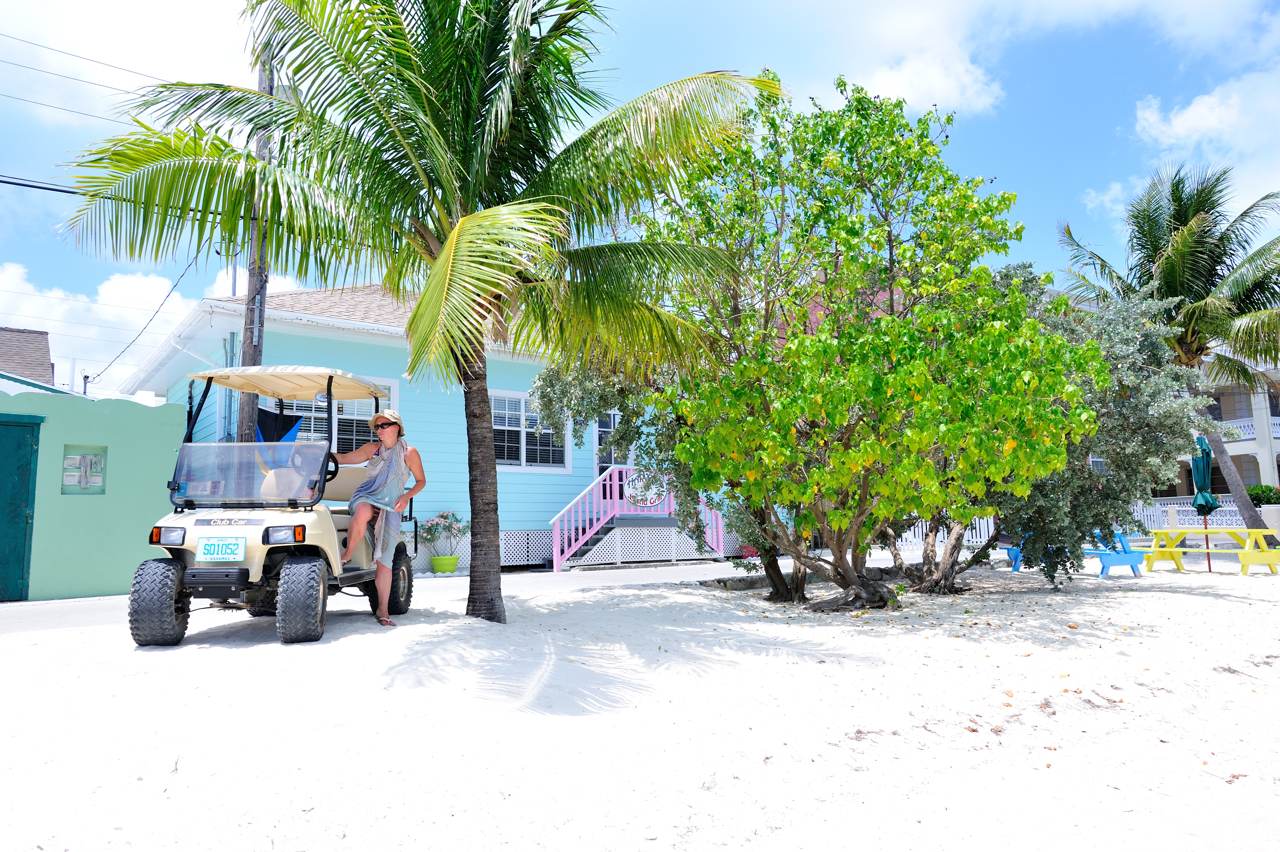
Bahamian People-to-People afternoon tea
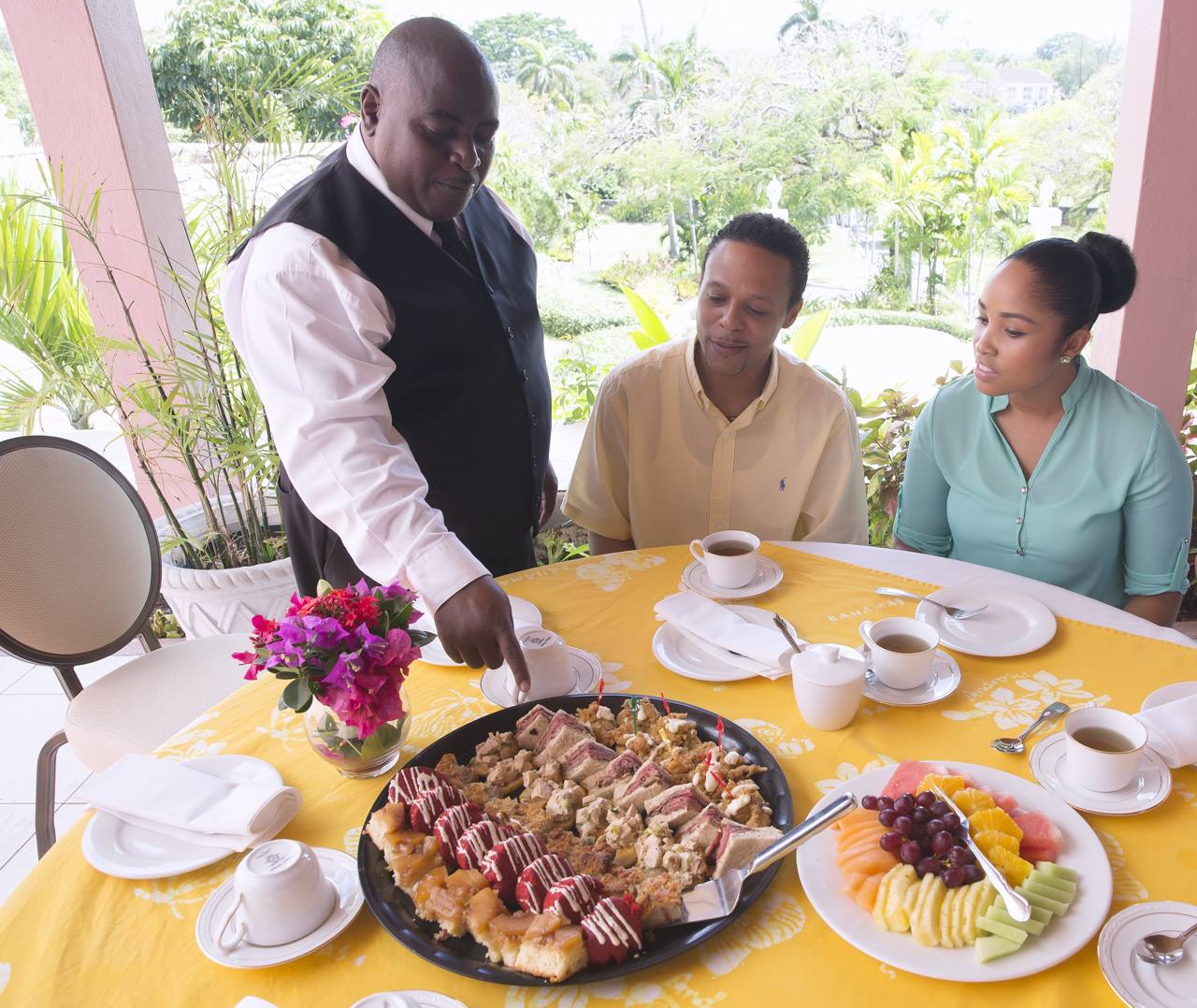
People to people tea party
In Nassau have afternoon tea at the historic and imposing Government House, the official residence of The Governor of The Bahamas. On the last Friday of the month the Bahamian People-to-People programme offers complimentary afternoon tea with a fashion show, live music and shuttle transfer to your hotel, providing luxury and colonial history for no charge.
Bahama Barrels: blend-your-own-wine experience

Bahama Barrels
The luxurious 18th century Graycliff Hotel is a Nassau institution and has recently introduced a range of experiences including Bahama Barrels, where you learn to blend your own wine in the oldest Church in the Bahamas (across the road from the main hotel). Guided by Jason, a Californian winemaker, you learn all about wine production, grapes and tasting. The experience concludes when you blend, name and bottle your very own bottle of wine to take home.
Cost: $49.95 per person (18+ Years). Available Monday to Saturday at 11:15am
Island Hopping – Harbour Island or Eleuthera
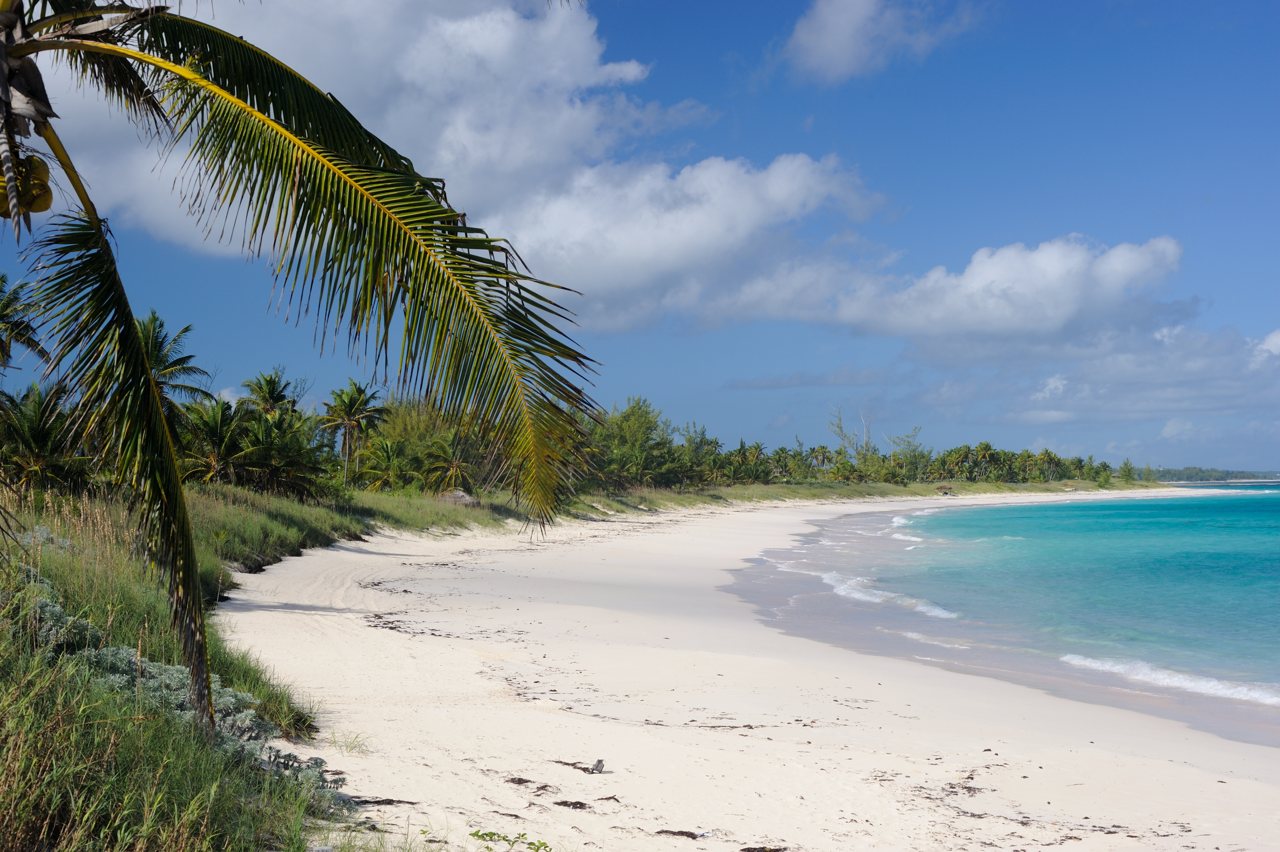
Eleuthera
Take a day trip from Nassau to Harbour Island or Eleuthera with Bahamas Ferries and navigate between the islands. Harbour Island is famous for its miles of candy-floss pink sand and celebrity guests, whereas Eleuthera has sweet pineapple farms dotting the landscape and ideal conditions for surfing on the Atlantic side. And if you fancy staying on the island, try glamping at The Other Side, a collection of luxury tents overlooking the ocean.
Fares from Nassau to Harbour island from $81
Meet the Dolphins at Blue Lagoon

Meet the Dolphins at Blue Lagoon
Just three miles from Nassau, Blue Lagoon Island, also known as Salt Cay, has water sports including paddle boarding and water bikes, as well as dolphins and sea lions. Visitors can swim with the animals and spend the day relaxing on a tranquil beach. It’s a great family day out.
A Blue lagoon Beach day including animal encounters and lunch is from $32 for an adult.
Dive with Hammered Sharks

Great Hammerheads (c) Judith Baker
The iconic hammerhead sharks can be seen in The Out Island of Bimini from December to April. The Bahamas was made a shark sanctuary in 2011, making killing sharks illegal and shark tourism has flourished. Diving with the hammerhead sharks is an unforgettable adventure as the huge creatures swim around you and come within an arm’s length.
Great Hammerhead Safari costs $299 at Neal Watson’s scuba centre based at The Bimini Big Game Resort & Marina, North Bimini
Swim with Pigs
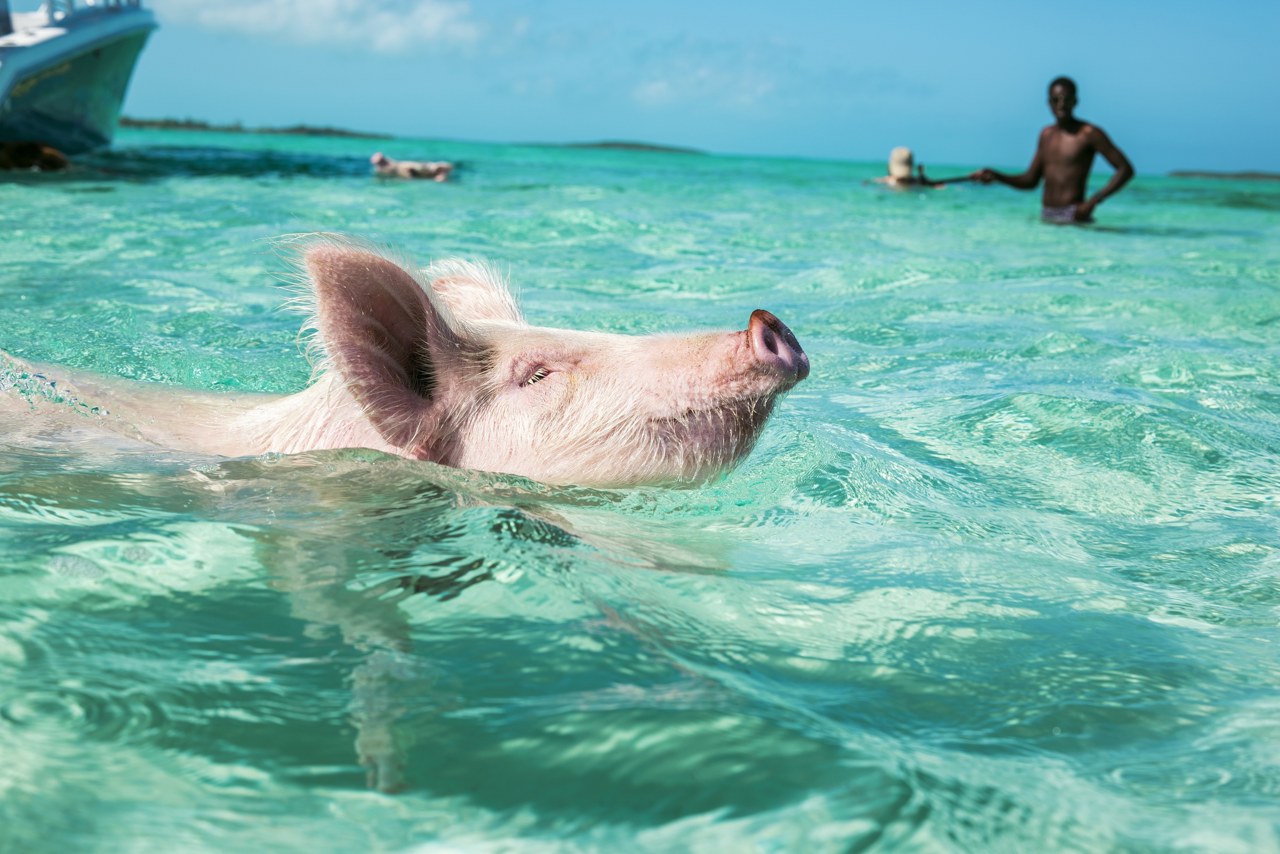
Swimming pigs in Exuma
The swimming pigs of The Exumas have become world famous but they can also be spotted on other islands including The Abacos. It is an incongruous but fascinating thing to see entire families of pigs running along a tropical beach in the sunshine and trotting into the water for a refreshing swim. Visitors can join them in the sea for dip when the pigs swim up for any free carrots.
Half day ocean safari in The Exumas on a power boat including swimming with pigs from $150
Sail and dive in Abaco Islands
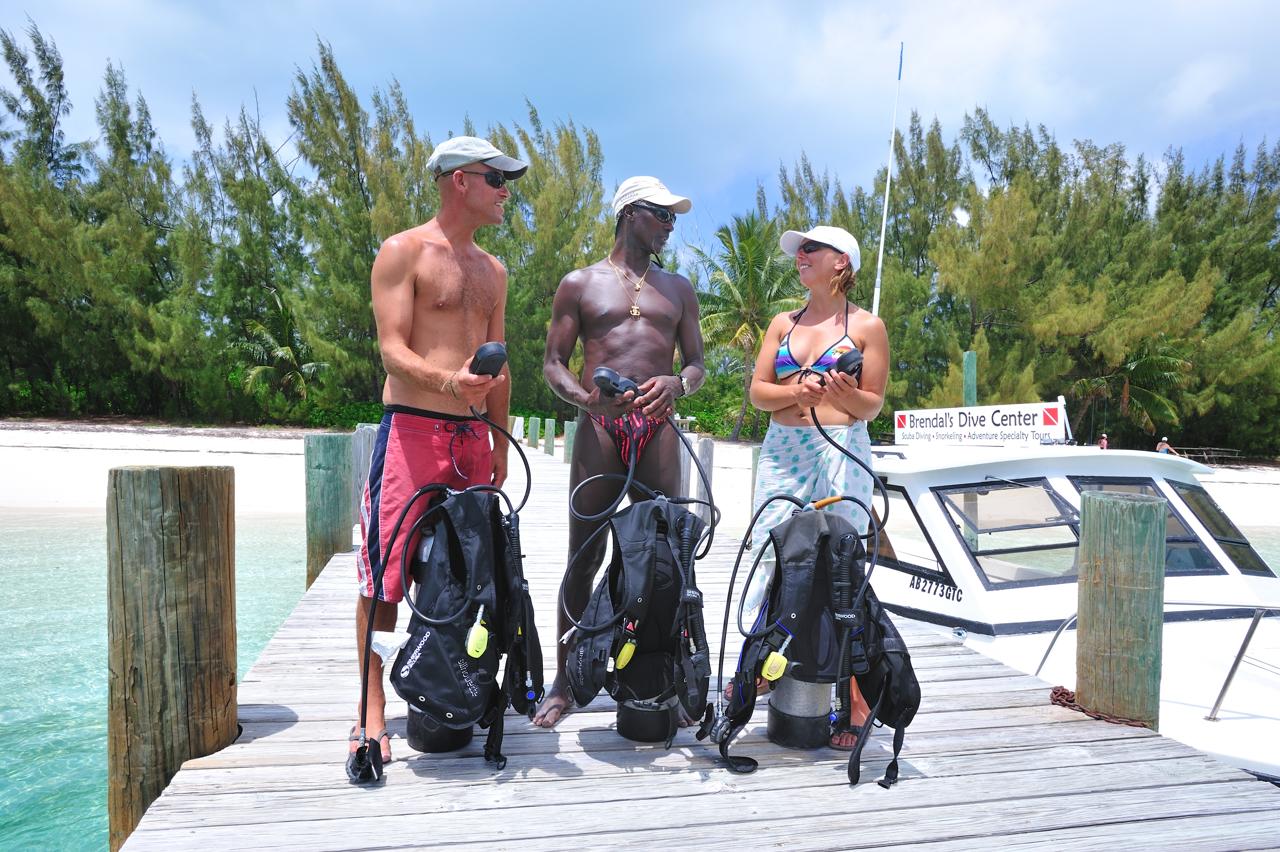
Brendal dive center
The 120-mile–long chain of The Abacos is ideal for boating and sailing. Book a day trip with Brendal, who has run the dive centre on Green Turtle Cay for 35 years. He will regale you with tall tales while showing you how to feed rays by placing bits of fish between your toes. Stop for snorkelling before a BBQ lunch on a deserted beach with fresh fish and lobster prepared by Brendal himself.
Or sea dogs can hire a boat for the day and make their own tour around the coast stopping at uninhabited cays or the historic New Plymouth with its colourful 18th century buildings. Daily rates from $90
Grand Bahama Island Fish Fry
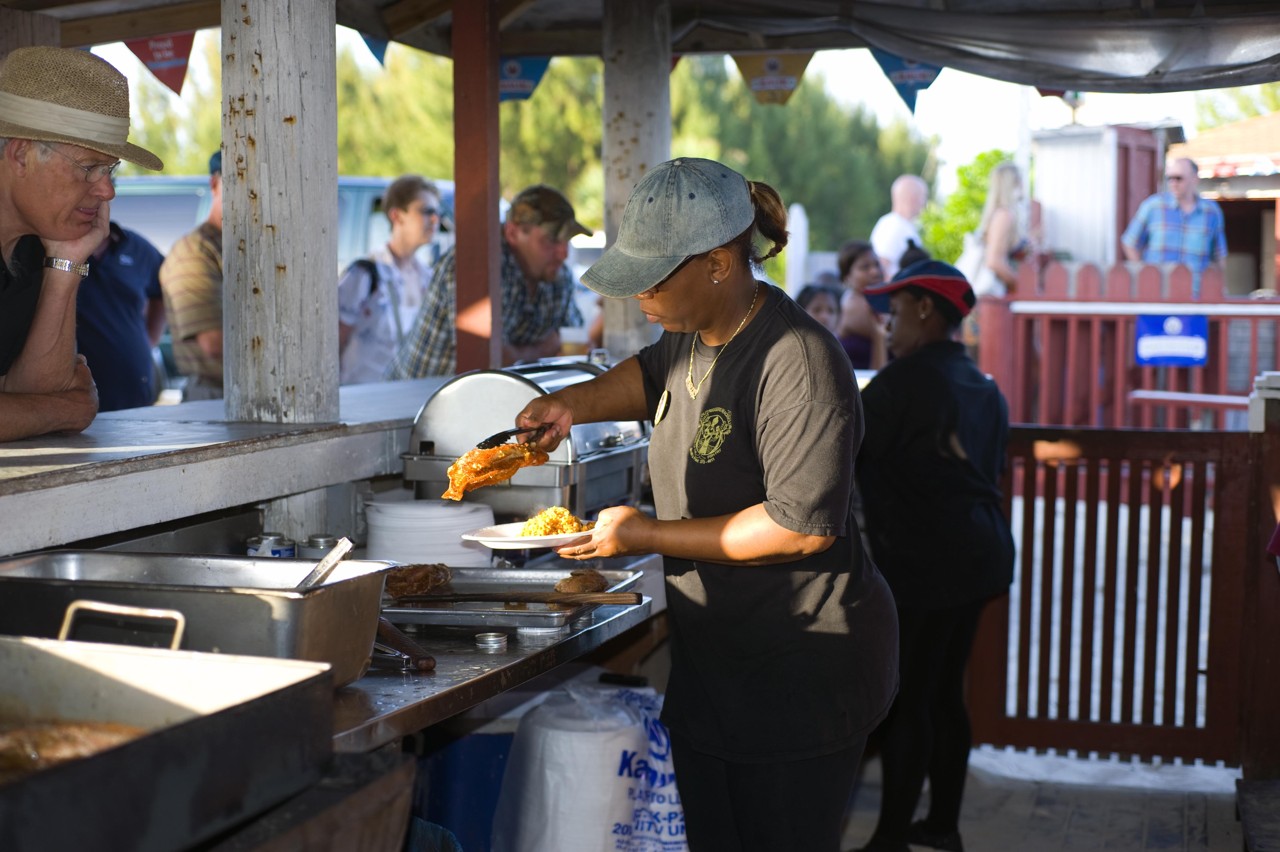
Smith’s Point Fish Fry
Fish Fry in The Bahamas dates back to pre-Colombian times and is a regular event throughout the islands with beach shacks serving food with a party atmosphere or small stalls cooking for locals. On Grand Bahama Island Wednesday night is the time to head to Smith Point. Get there early (about 6) before the queues form. Eat at tables overlooking the lovely beach and watch the sunset, then party until the small hours with music and dancing enjoyed by locals and tourists alike.
A fish dinner with fresh snapper or grouper, rice and peas and sides is about $12. Don’t miss the guava duff for pudding and wash it down with a rum punch or local Kalik beer. No need to book in advance – just take a taxi or shuttle, anyone will tell you where it is.
Dive into The Blue Hole
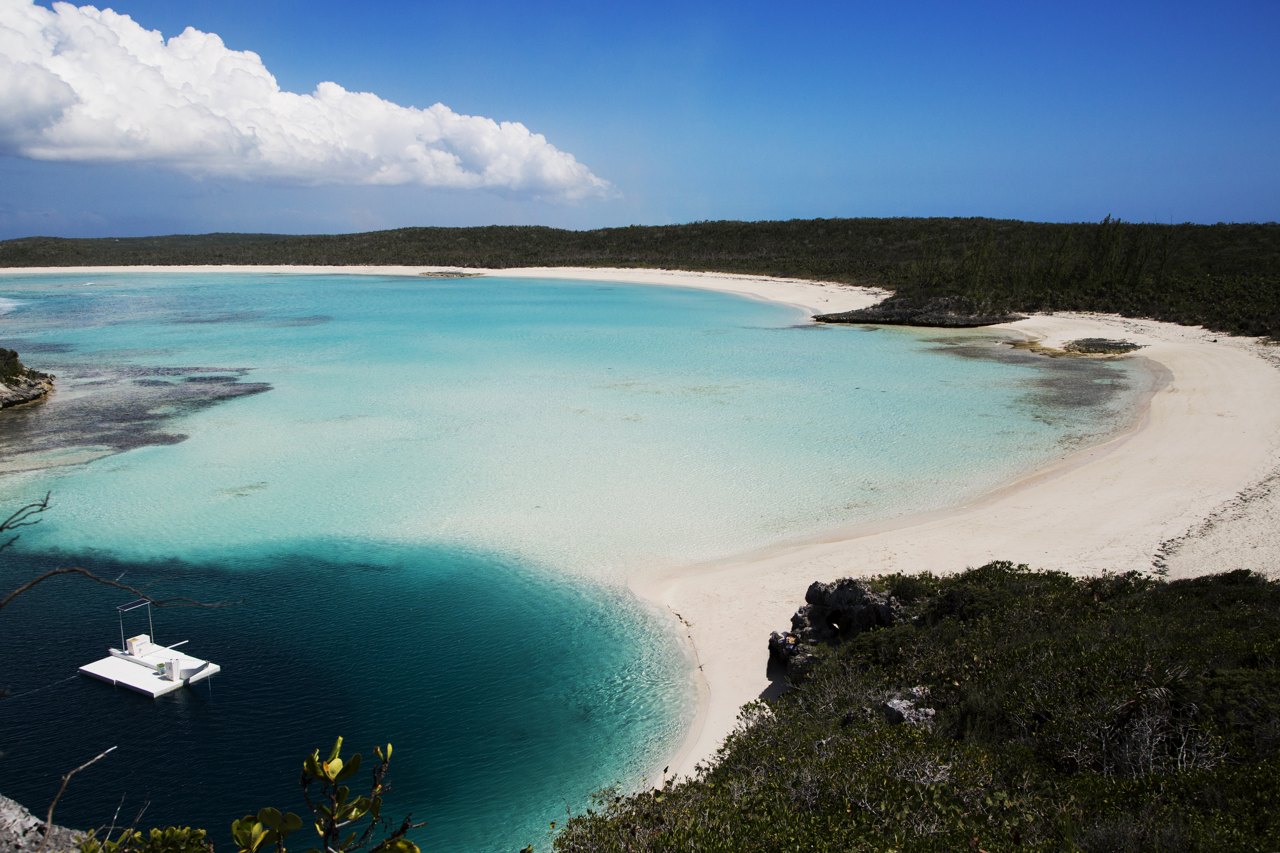
Dean’s Bluehole
Dean’s Blue Hole on Long Island is the world’s second deepest blue hole at 633 feet below ground. It leads to the world’s eighth largest underwater cavern – filled with amazing marine life and fabulous colours. Perfect for shore divers, Dean’s Hole is also a mecca for free divers since the world Free Diving record was set here in 2007. Head here to snorkel and spot seahorses, rays, turtles and tarpons.
Deans Blue Hole is near Clarence Town, Long Island.
Try Conch Fritters
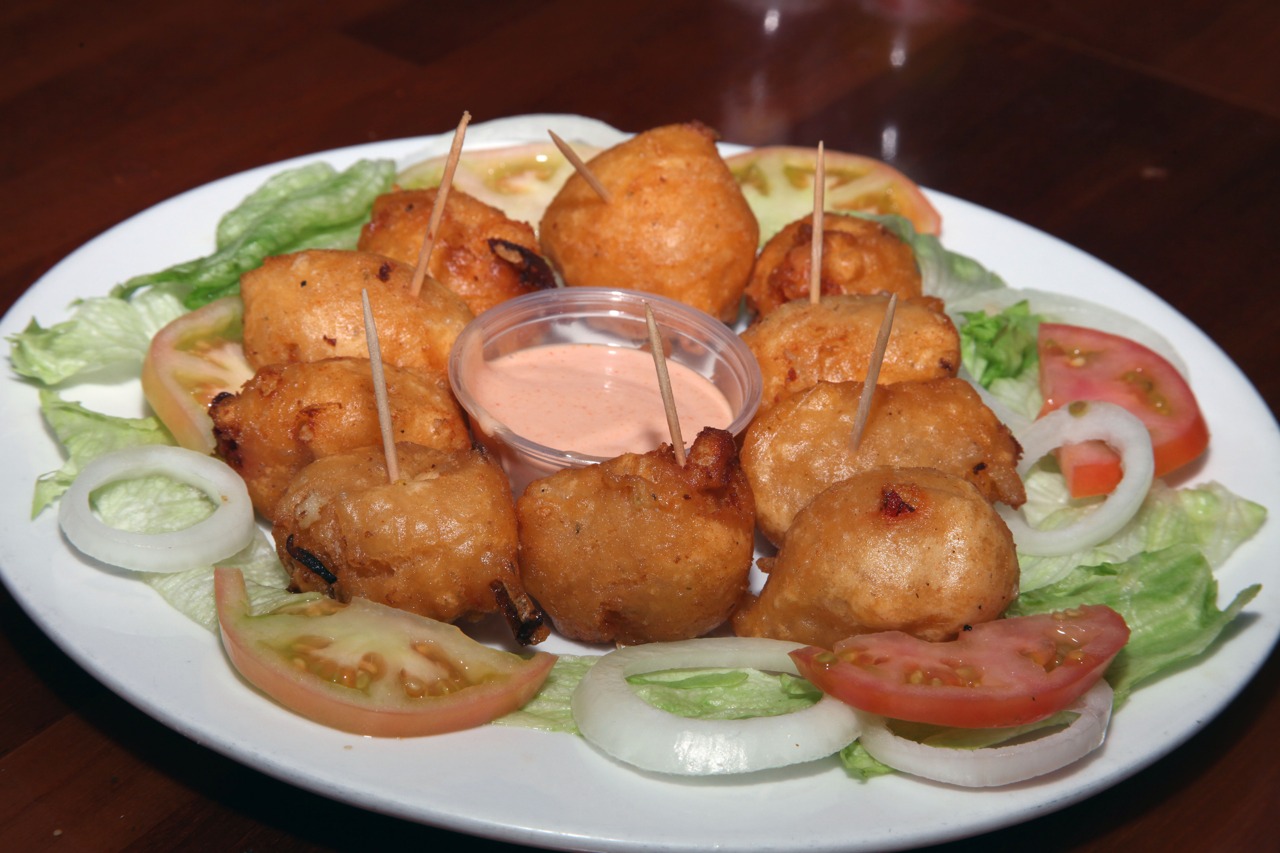
Conch Fritters
Conch (or conk as it is called here) is a pretty, pink, edible mollusc eaten throughout the region but a particular favourite in The Bahamas. Don’t leave without trying Conch Fritters: just one of a myriad ways of eating, these bite size fritters are the ideal appetiser at any time of the day and go especially well with a Bahama Mama cocktail or local beer like Kalik or Sands Radler which is a light fruity beer flavoured with grapefruit. Stop off at one of the many colourful conk stalls dotted throughout the islands.
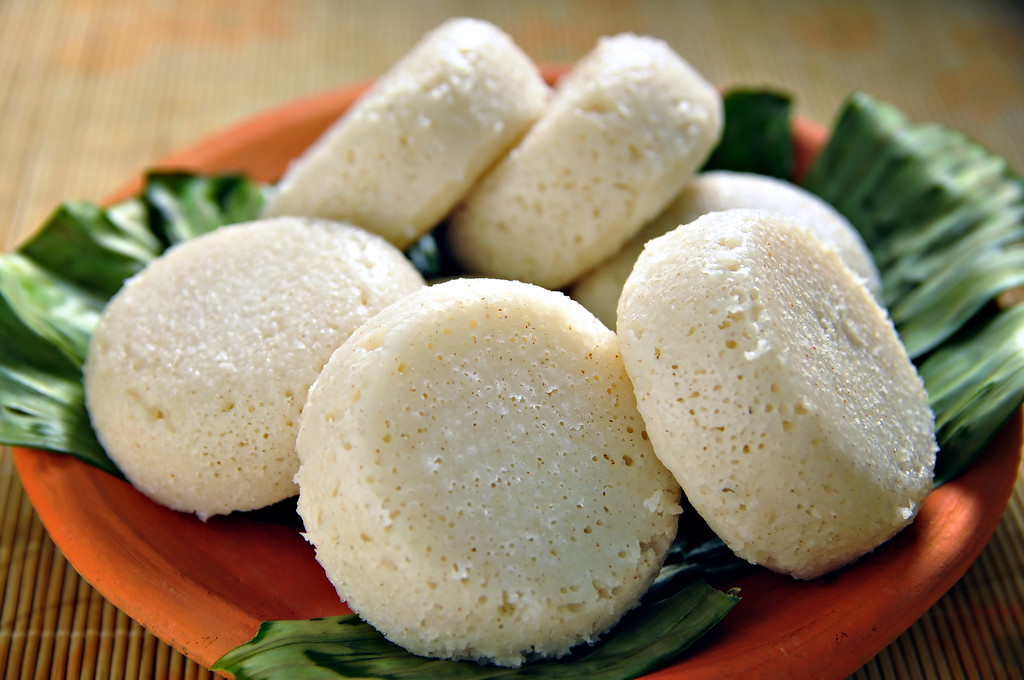
Goan Idli Recipe
Goan Idli, also called ‘Sana’ are soft rice cakes made from rice, urad dal and coconut milk. Goan Idlis are very similar to the usual idlis and are best paired with sambhar and chicken curries. These idlis are widely consumed in Goa and some parts of Mangalore as well. These soft idlis will just melt in your mouth due to their soft and different texture. The batter which is prepared for these Goan Idlis is fermented first with the help of yeast, which differentiates them from usual idlis. The batter is mixed with coconut milk which gives it the much-needed softness. If you love South Indian cuisine, then you need to try this unique idli recipe. You can prepare these idlis for breakfast, lunch or even dinner. We have used Basmati rice to prepare the batter but you can use any rice of your choice. If you plan to lay out a Goan spread in one of your parties then this delicious dish must be included in the menu for sure. Do try this recipe, rate it and let us know how it turned out to be.
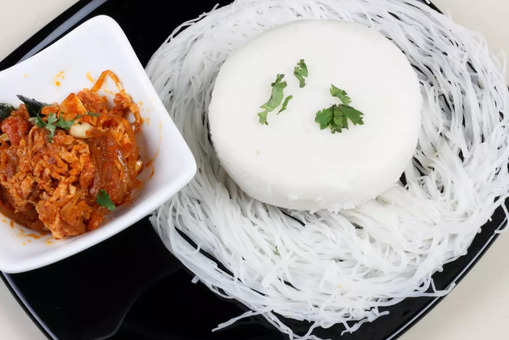
Ingredients of Goan Idli
- 2 cup parboiled basmati rice
- 3 teaspoon sugar
- salt as required
- water as required
- 3/4 cup urad dal
- 1 teaspoon dry yeast
- 3/4 cup coconut milk
How to make Goan Idli
Step 1 Soak and grind rice and dalIn two separate bowls, soak rice and urad dal for 4-5 hours. Drain both the rice and dal. In a grinder or blender, add some water and grind the rice to make a batter that is smooth. The batter should not be runny and have a thick consistency. Grind the dal separately.
Step 2 Mix the ingredientsPour the rice batter and dal batter in a large bowl along with coconut milk and whisk to make a smooth batter. Add salt, 2 teaspoons sugar, mix and keep the batter aside. In a small bowl, mix yeast, 1 teaspoon sugar and 1/4 cup warm water and keep aside.
Step 3 Add yeast to batterLeave the yeast mixture to rest for at least 10 minutes and then add it to the batter. After you mix yeast with the batter, cover the large bowl and keep aside to ferment for 2-3 hours.
Step 4 Steam the idlisGrease the idli moulds, pour the batter in required quantities and steam the idlis for about 20 minutes. After the idlis are steamed, remove them from the moulds and serve hot.
Tips
- To make the idlis spongier, whisk the batter for at least 6-8 minutes before steaming the idlis.

Coconut Suji Cake Recipe
If you are fond of baking cakes at home, then add this Coconut Suji Cake to your list. With its chewy texture and classic flavours, Coconut Suji Cake will leave you craving for more. For all the coconut lovers out there, this cake is a must-try. To prepare this recipe, you just need a handful of ingredients. The combination of suji cooked in milk and combined with sugar and cocoa powder is indeed heavenly. A final garnish of desiccated coconut on the tops acts as a cherry on the cake. We have used plain milk here but if you want to enhance the coconut flavours even further, then use coconut milk. Ingredients like almonds, cashews, raisins, walnuts, dried tutti-frutti, choco chips etc can also be mixed with the batter to add more flavours to the coconut cake. You can use jaggery powder or any other sweetener of your choice instead of white sugar to make the cake healthier. You can bake this coconut cake for parties, birthdays, anniversaries, get-togethers etc and everyone will love it for sure. Do try this recipe, rate it and let us know how it turned out to be.
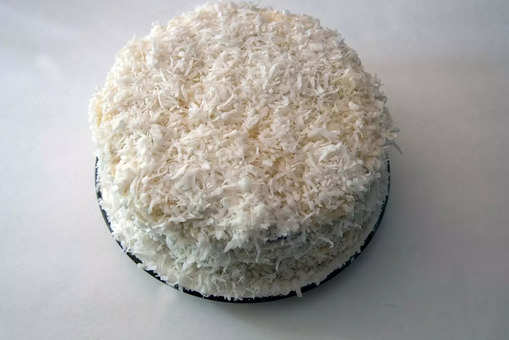
Ingredients of Coconut Suji Cake
- 1 cup semolina
- 1 1/4 cup milk
- 1/4 cup unsweetened cocoa powder
- 1 teaspoon baking powder
- 6 tablespoon desiccated coconut
- whipped cream as required
- 1/2 cup powdered sugar
- 1/4 cup unsalted butter
- 1 teaspoon vanilla essence
- 1/2 teaspoon baking soda
- 1 Pinch salt
How to make Coconut Suji Cake
Step 1 Mix the dry ingredientsIn a mixer, grind suji for 1 minute until you achieve a fine suji flour. Take it out in a bowl and add cocoa powder and salt.
Step 2 Mix milk with other ingredientsIn a vessel, add milk, butter, sugar (keep 2 tbsp aside for later) and vanilla essence and keep on low flame until sugar is dissolved completely. Do not boil the mixture.
Step 3 Make a batterAdd this warm mixture to the dry ingredients slowly and keep mixing until well combined. Cover and let the batter rest for 15 minutes. Meanwhile, pre-heat the oven at 180 degrees Celcius for 15 minutes. Grease and dust flour on your baking tin. Once rested, add the baking powder and baking soda to the cake batter and mix well, do not whip or over mix the batter.
Step 4 Bake the cakePour this cake batter into a baking tin and bake at 180 degrees Celcius for 25-30 minutes, or until a toothpick comes out clean.
Step 5 Roast the desiccated coconutIn a pan, roast the desiccated coconut on low flame until it turns golden in colour. Remove onto a plate and let it cool down a bit. Mix it with 2 tbsp powdered sugar.
Step 6 Garnish and serveSpread some whipped cream on the baked cake and garnish it with coconut mixture. Make sure the entire surface and sides are lightly coated with coconut flakes. Once done, cut into pieces and serve.
Tips
- You can use coconut milk instead of plain milk for that extra coconut punch.
- Add nuts of your choice to make the cake tastier.
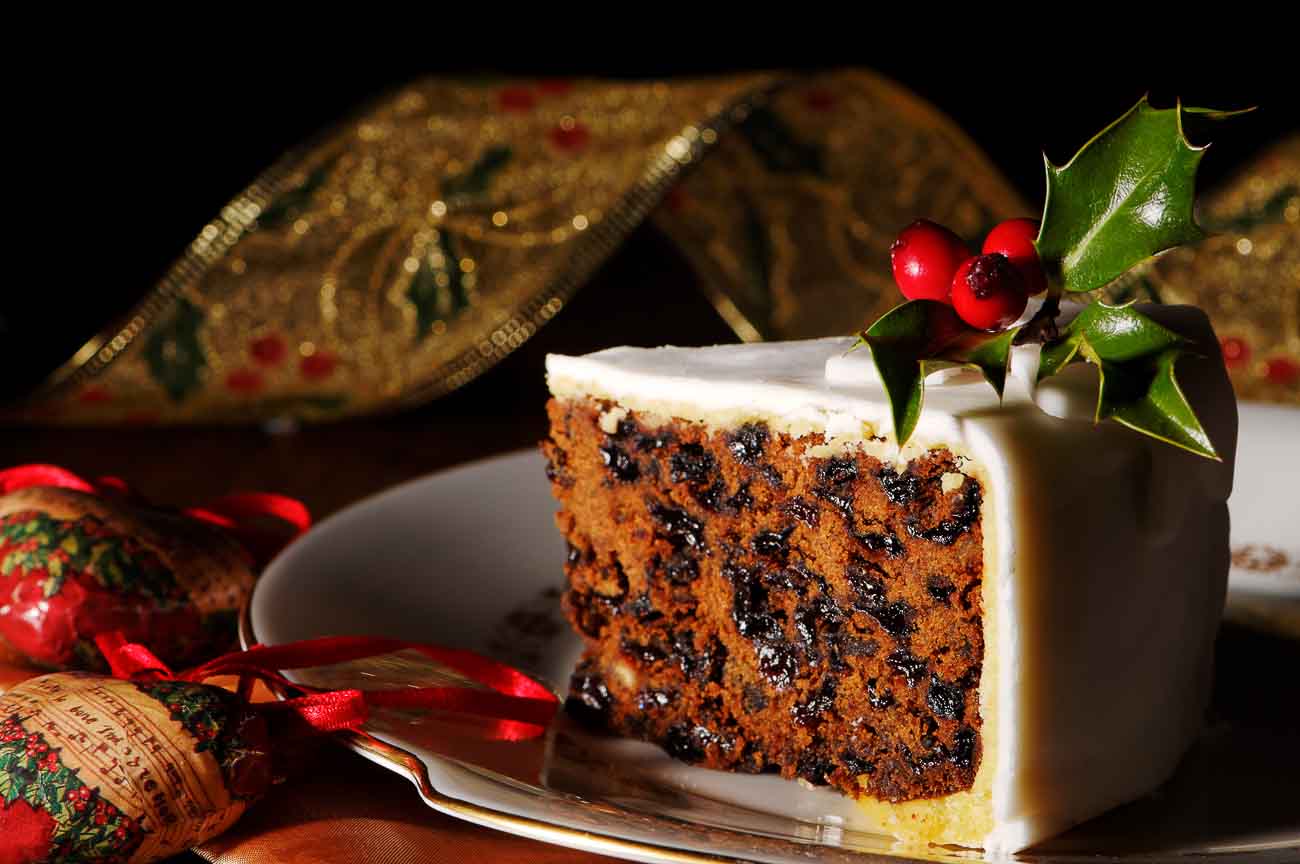
Eggless Christmas Cake Recipe
Christmas is around the corner and it is the perfect time to get baking in order to celebrate the most popular winter festival. Christmas is widely associated with baked food items, especially cakes. Date and Walnut cake is the most popular variant that most people prefer baking as it is not only super easy but also super delicious. We have used only walnuts in the recipe but if you like, you can add cashews, almonds, raisins, candied fruits etc. If you love baking at home, then you need to bookmark this recipe. Most cakes available in the market have egg as an ingredient which might not suit people who are vegetarians or those having egg allergies. We have the perfect solution for you guys. This eggless Christmas Cake will be equally fluffy and tasty as any other egg cake. Be it kids or adults, everyone will love this Khajoor Cake for sure. You can easily store the baked cake in an airtight jar and it will easily last a week. Do try this recipe, rate it and let us know how it turned out to be.

Ingredients of Eggless Christmas Cake
1 cup pitted dates
2 cup whole wheat flour
1/4 cup yoghurt (curd)
1 teaspoon baking powder
2 tablespoon powdered sugar
1/2 cup walnuts
1 1/2 cup lukewarm milk
1/2 cup vegetable oil
1/2 teaspoon baking soda
How to make Eggless Christmas Cake
Step 1 Blend the datesAdd dates to a bowl. Add 1 cup warm milk and let them soak for 15 minutes. Add dates along with milk to a blender. Blend to form a thick paste.
Step 2 Mix the ingredientsAdd the date paste to a large bowl. Add oil, curd and use an electric whisker to mix the ingredients together. Keep whisking until you get a smooth mixture.
Step 3 Sift the dry ingredientsNow keep a sieve in the bowl and add wheat flour. Also, add baking powder and baking soda. Sift the dry ingredients into the bowl. Now use the cut and fold method to mix them well with the rest of the ingredients. Add 1/2 cup warm milk and again mix well to get a smooth batter.
Step 4 Add dates and walnutsNow add 6-8 chopped dates and 1/2 cup chopped walnuts to the batter. Give a final mix.
Step 5 Bake the cakePour the batter into a rectangular tin lined with parchment paper or greased properly with oil. Bake the cake for 45 minutes at 180 degrees Celcius.
Step 6 Ready to be servedOnce baked, take it out from the oven, let it cool down properly. Cut the cake into pieces and serve.
Tips
- You can add some candied fruits and more nuts for added flavour.
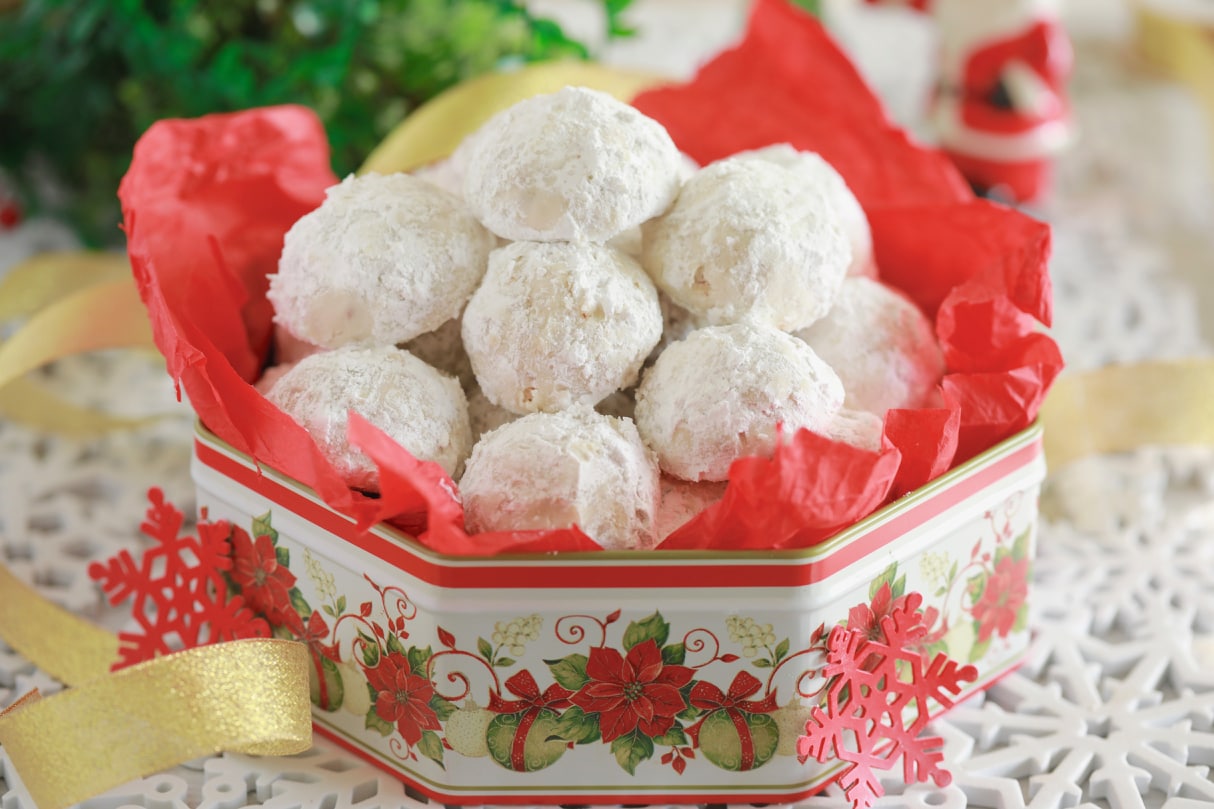
Snowball Cookies Recipe
Winter season brings one of the happiest festivals of the year, that is Christmas. Right from decorating Christmas trees and exchanging gifts to baking cakes and hosting parties, Christmas brings happy vibe to the gloomy winter season. If you are someone who loves baking homemade goodies during Christmas, then this super easy recipe is perfect for you. Snowball Cookies are the specialty of Goa during Xmas. These cookies are prepared using just 4-5 ingredients and will be ready in less than 30 minutes. Be it kids or adults, everyone will love these Snowball Cookies for sure. These Snowball Cookies are not only flavourful but also beautiful to look at because of their snowy-white appearance. Once baked, Snowball Cookies are coated with powdered sugar, which makes them look snow-clad. If you are hosting a Christmas party at home, then don’t forget to include this special cookie on your menu. Do try this recipe, rate it and let us know how it turned out to be.
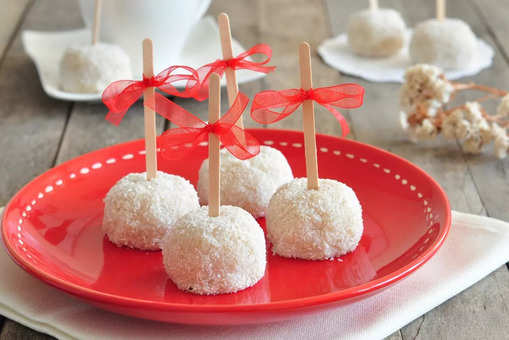
Ingredients of Snowball Cookies
1 cup refined flour
1 tablespoon corn flour
1/4 cup powdered sugar
1/2 cup butter
1 teaspoon baking powder
1/4 teaspoon salt
How to make Snowball Cookies
Step 1 Mix the ingredientsAdd butter and sugar to a bowl. Mix it well until a creamy mixture is formed. Now add flour, cornflour, baking powder and salt to the butter-sugar mixture. Keep folding it until well combined.
Step 2 Refrigerate itOnce a soft dough is formed, cover it and keep it in the fridge for 20 minutes.
Step 3 Make small ballsNow pinch out small balls from the dough, roll them between your hands to form a smooth ball and place it on a baking tray lined with parchment paper.
Step 4 Bake, garnish and serveBake the cookies for 15-20 minutes at 170 degrees Celsius. Once baked, garnish them with powdered sugar or icing of your choice.
Tips
- You can mix powdered coconut and sugar and coat the cookies in the mixture.
- Add nuts or dried fruits of your choice to add to the taste.




